Earth’s Reflection: International Juried Exhibition

When the Earth sees its reflection, will it be proud or scared of what it’s become?
For this exhibition, the Trolley Barn Gallery brought together a compassionate roster of artists who specialize in work that brings attention to pollution prevention in a way that offers solutions for one of humanity’s most pressing global crises. This exhibition focused on artistic interpretations of pollution prevention including themes of environmental justice and climate change activism. Artists explored themes inspired by the Earth; translating the sciences of ecology and geology to an experiential art. This exhibition featured artists working in 2D and 3D mediums of upcycled materials, sound, video, and performance.
We are looking back at our mistakes, looking forward to solutions, and holding space for our present circumstances. And with the education and support of local artists and activists, the youth curators have equipped themselves with the skills to think outside the box and inspire collective action in Poughkeepsie.
Special Events
Opening Reception | Friday, June 14 | 6 – 8PM
UPSTATE ART WEEKEND: July 19 – 20
• Community Clean Up | Friday, July 19 | 12 – 2:30PM
• Sustainability Lecture | Friday, July 19 | 4 – 5PM
• Upcycled Art Workshop | Saturday, July 20 | 12 – 4PM
Community Clean Up | Saturday, August 3 | 12 – 2:30PM
“Stewards of the Water” Panel Discussion | Saturday, August 3 | 3 – 5PM
Funding provided by the Environmental Protection Fund as administered by the New York State Department of Environmental Conservation. Any opinions, findings, and/or interpretations of data contained herein are the responsibility of the author(s) and do not necessarily represent the opinions, interpretations, or policy of Rochester Institute of Technology and its NYS Pollution Prevention Institute or the State.
Gallery Hours
Thursday – Friday, 2–5pm
Saturday, 12–4pm
Earth’s Reflection: Virtual Gallery
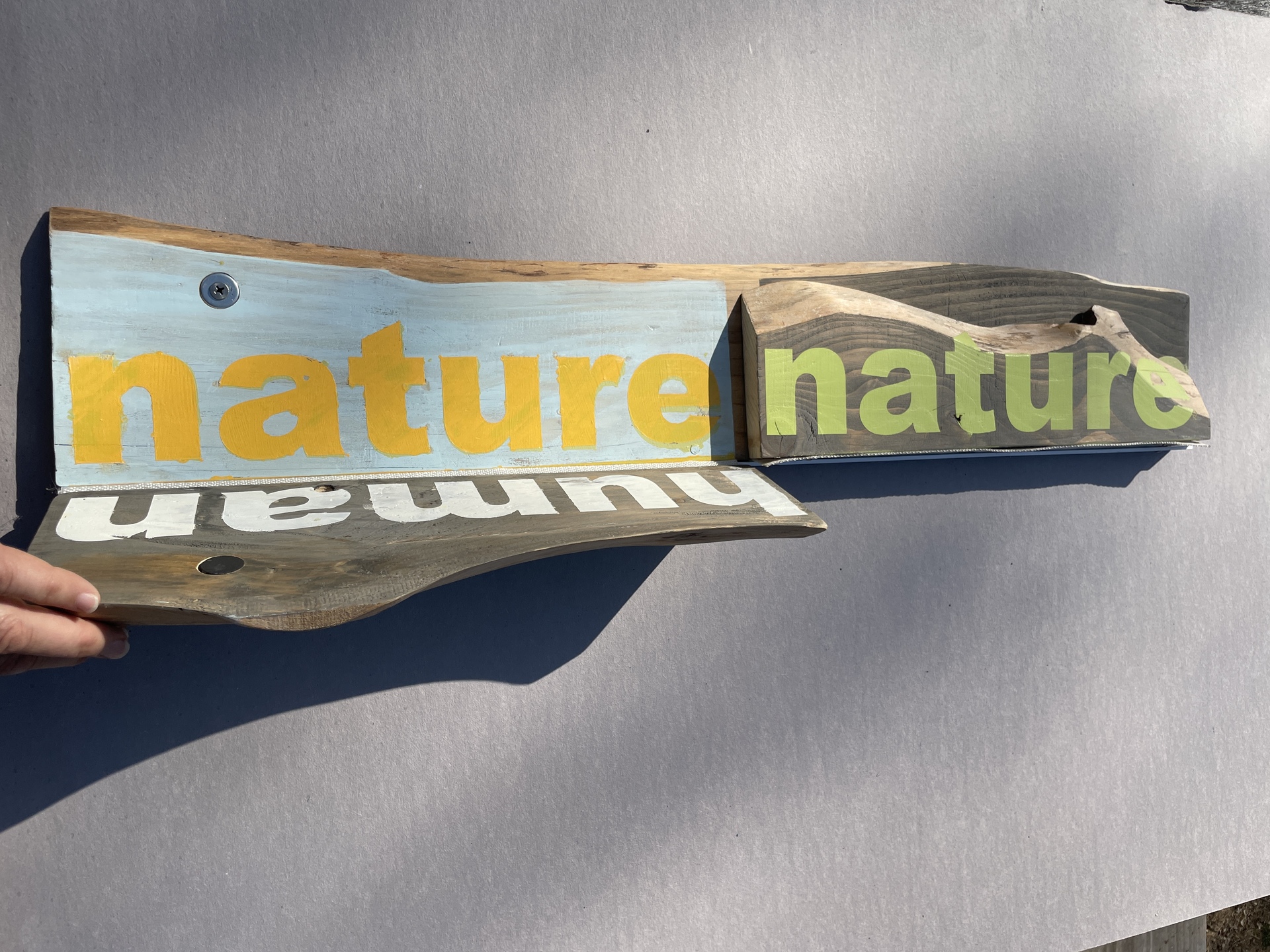 Mary Ann Agresti • human nature 3 • reclaimed pine, paint, nylon webbing, aluminum, magnets • 12” x 31” x 1.5” • Yarmouth, MA • $1,200 • Bringing a visual and interactive element to thinking of how the world interacts, this work is an invitation for viewers to challenge themselves to think about how humans and nature are complements, opposites, and competitors with one another. Looking at the different ways to compare the two provides an interesting and necessary thought on how nature should be interacted with. The piece can be changed to say “human nature”,” human human”,” nature nature”, or” nature human”.
Mary Ann Agresti • human nature 3 • reclaimed pine, paint, nylon webbing, aluminum, magnets • 12” x 31” x 1.5” • Yarmouth, MA • $1,200 • Bringing a visual and interactive element to thinking of how the world interacts, this work is an invitation for viewers to challenge themselves to think about how humans and nature are complements, opposites, and competitors with one another. Looking at the different ways to compare the two provides an interesting and necessary thought on how nature should be interacted with. The piece can be changed to say “human nature”,” human human”,” nature nature”, or” nature human”.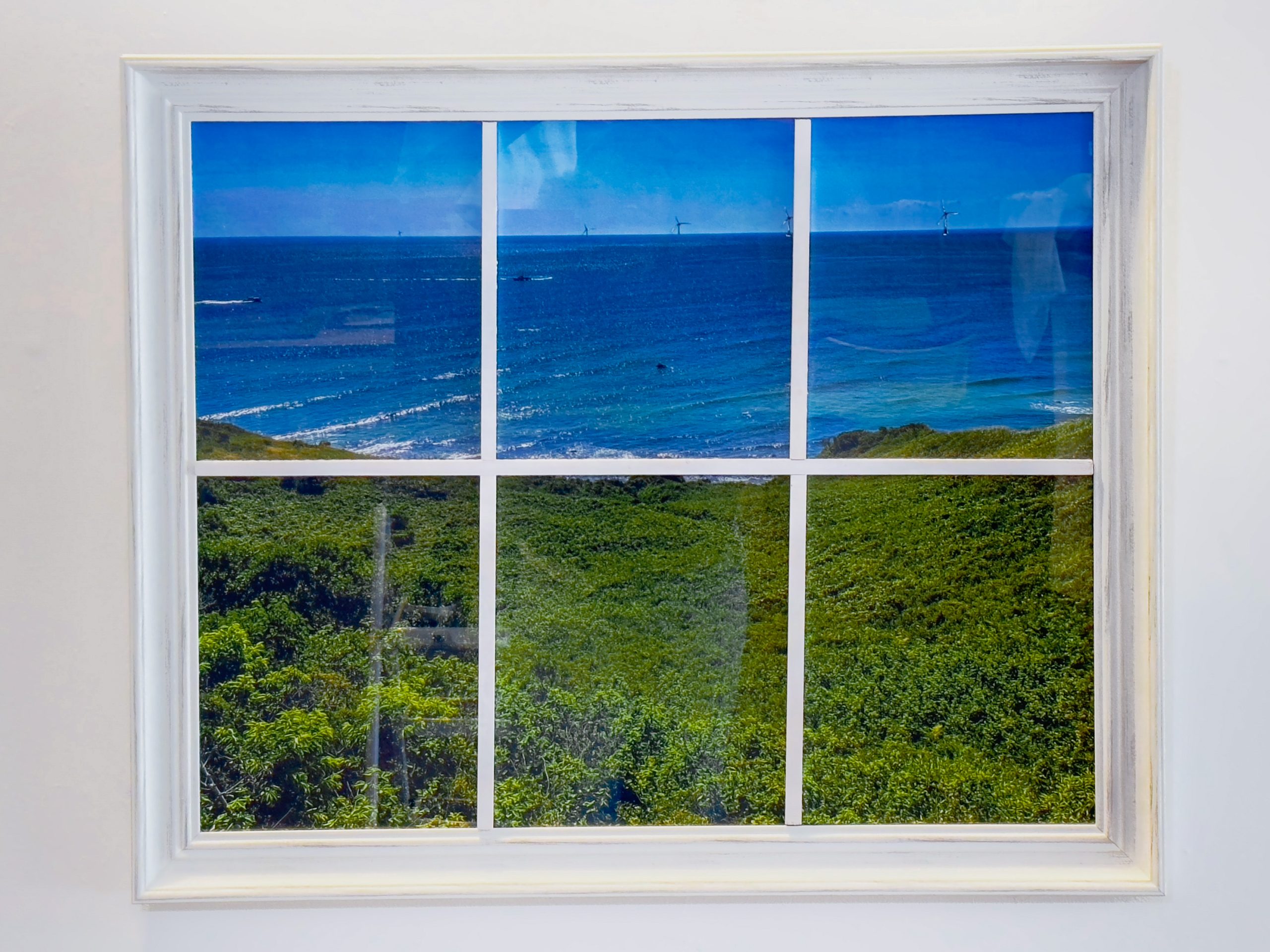 Destiny Arianna • "What's In The Water?" • Window, curtains, wood, crochet blanket, newspaper, plant, glass, ceramic, digital photograph • 80” x 96” x 48” • Wappingers Falls, NY • NFS • Arianna explores her connection to the island of Noepe (Martha’s Vineyard), where her Indigenous ancestors lived for years - now home to America’s first large-scale offshore wind farm. What’s In The Water? engulfs viewers in the warm feeling of home and the detachment that can be experienced after significant changes occur. A rocking chair with Arianna’s late great-grandmother’s crochet blanket drapes beside a wooden table where a photograph of Noepe - untouched and pure - sits. The window depicts the first hundred “eco- friendly” wind turbines outlined in white in the distance, ready to take over the entire landscape. Every aspect of the room has an ongoing conversation on the waters before and after the wind project. This work tells the story of a forgotten history as Arianna holds space for memory, nostalgia, and legacy.
Destiny Arianna • "What's In The Water?" • Window, curtains, wood, crochet blanket, newspaper, plant, glass, ceramic, digital photograph • 80” x 96” x 48” • Wappingers Falls, NY • NFS • Arianna explores her connection to the island of Noepe (Martha’s Vineyard), where her Indigenous ancestors lived for years - now home to America’s first large-scale offshore wind farm. What’s In The Water? engulfs viewers in the warm feeling of home and the detachment that can be experienced after significant changes occur. A rocking chair with Arianna’s late great-grandmother’s crochet blanket drapes beside a wooden table where a photograph of Noepe - untouched and pure - sits. The window depicts the first hundred “eco- friendly” wind turbines outlined in white in the distance, ready to take over the entire landscape. Every aspect of the room has an ongoing conversation on the waters before and after the wind project. This work tells the story of a forgotten history as Arianna holds space for memory, nostalgia, and legacy.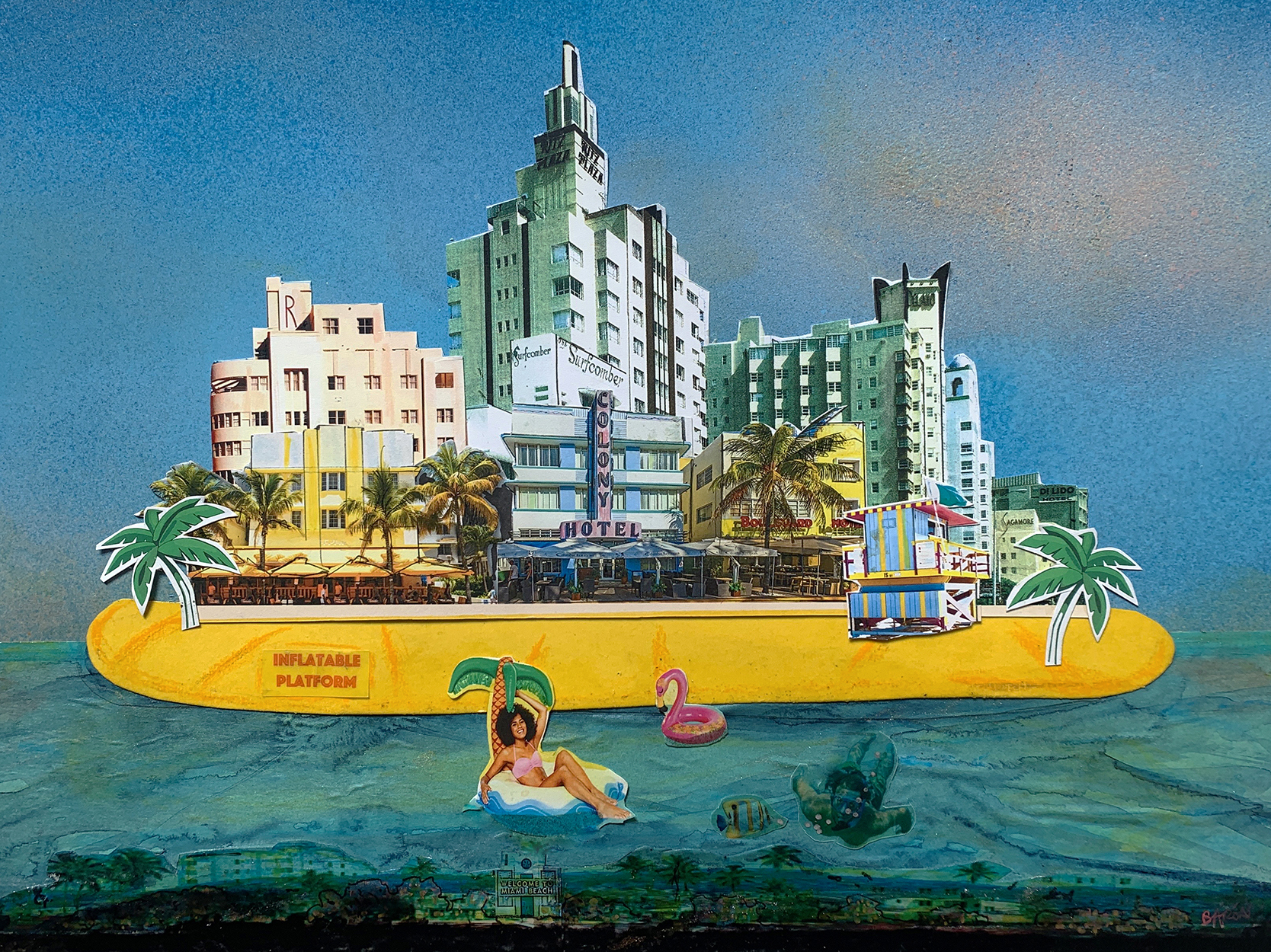 Brandin Barón • Concept Drawing for the Relocation of Miami Beach • collage with mixed media • 17” x 21” • San Francisco, CA • $1,000 • Baron collages vacation images together to depict a man-made island floating, designed to recreate the forgotten paradise. This work is a comical illustration of the way humans will laugh in the face of tragedy and go on in their relaxed, distracted bliss. Voluntary obliviousness is the face of a horrible but predictable situation as the Miami Beach is no longer able to naturally hold itself up.
Brandin Barón • Concept Drawing for the Relocation of Miami Beach • collage with mixed media • 17” x 21” • San Francisco, CA • $1,000 • Baron collages vacation images together to depict a man-made island floating, designed to recreate the forgotten paradise. This work is a comical illustration of the way humans will laugh in the face of tragedy and go on in their relaxed, distracted bliss. Voluntary obliviousness is the face of a horrible but predictable situation as the Miami Beach is no longer able to naturally hold itself up.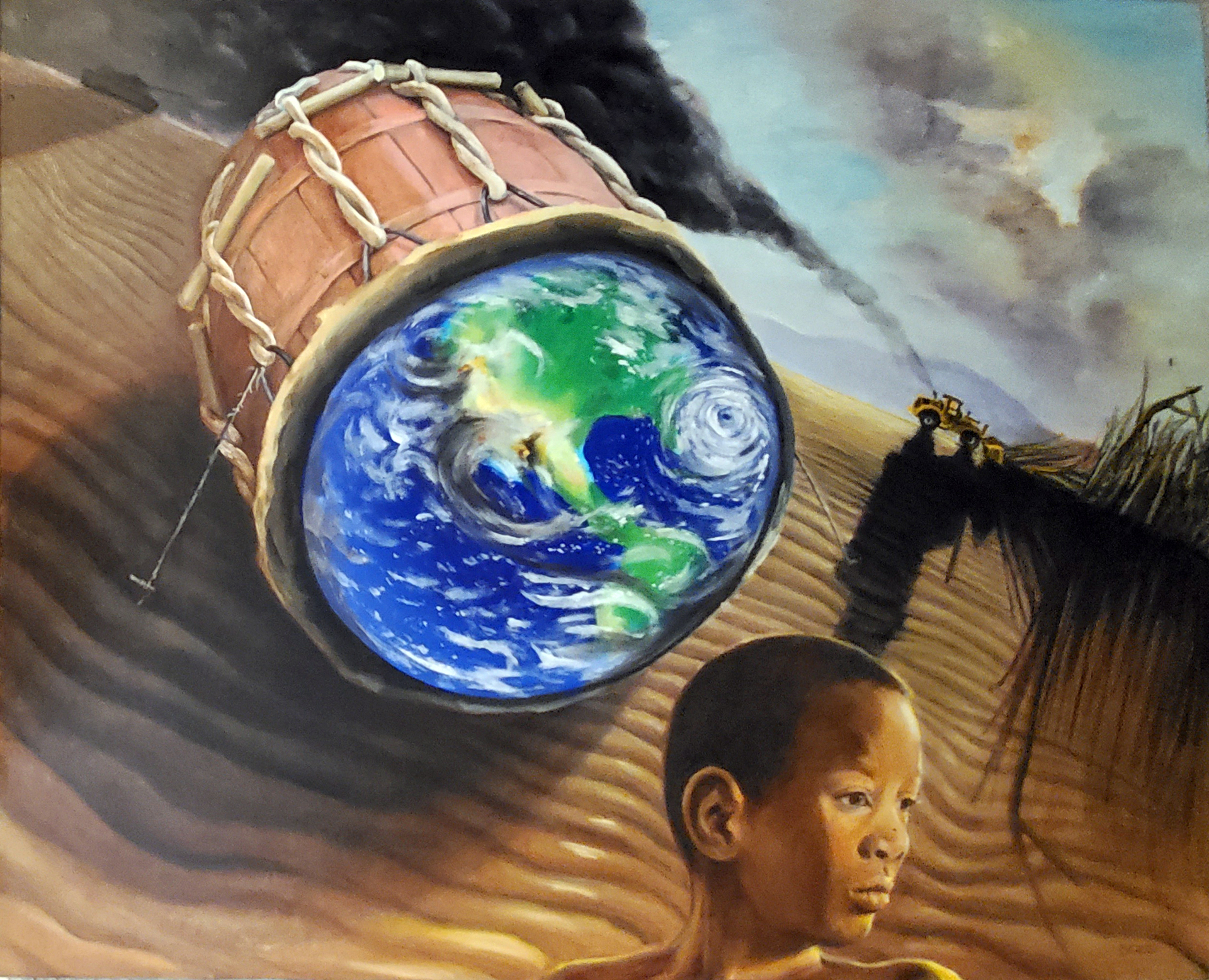 Barbara Bose • Inheritance • Oil on canvas • 24” x 30” • West Palm Beach, FL • $2,500 • One of the few things I noticed first was the tractor and the tank. War and revolution. Slavery. The drum is a reminder of a lot of things that have affected American history. Farming, loss of crops, war, and famine still happen everywhere else, but we don’t talk about that. Certain cultures all over the world use drumming for war, for celebration, for cadence.
Barbara Bose • Inheritance • Oil on canvas • 24” x 30” • West Palm Beach, FL • $2,500 • One of the few things I noticed first was the tractor and the tank. War and revolution. Slavery. The drum is a reminder of a lot of things that have affected American history. Farming, loss of crops, war, and famine still happen everywhere else, but we don’t talk about that. Certain cultures all over the world use drumming for war, for celebration, for cadence.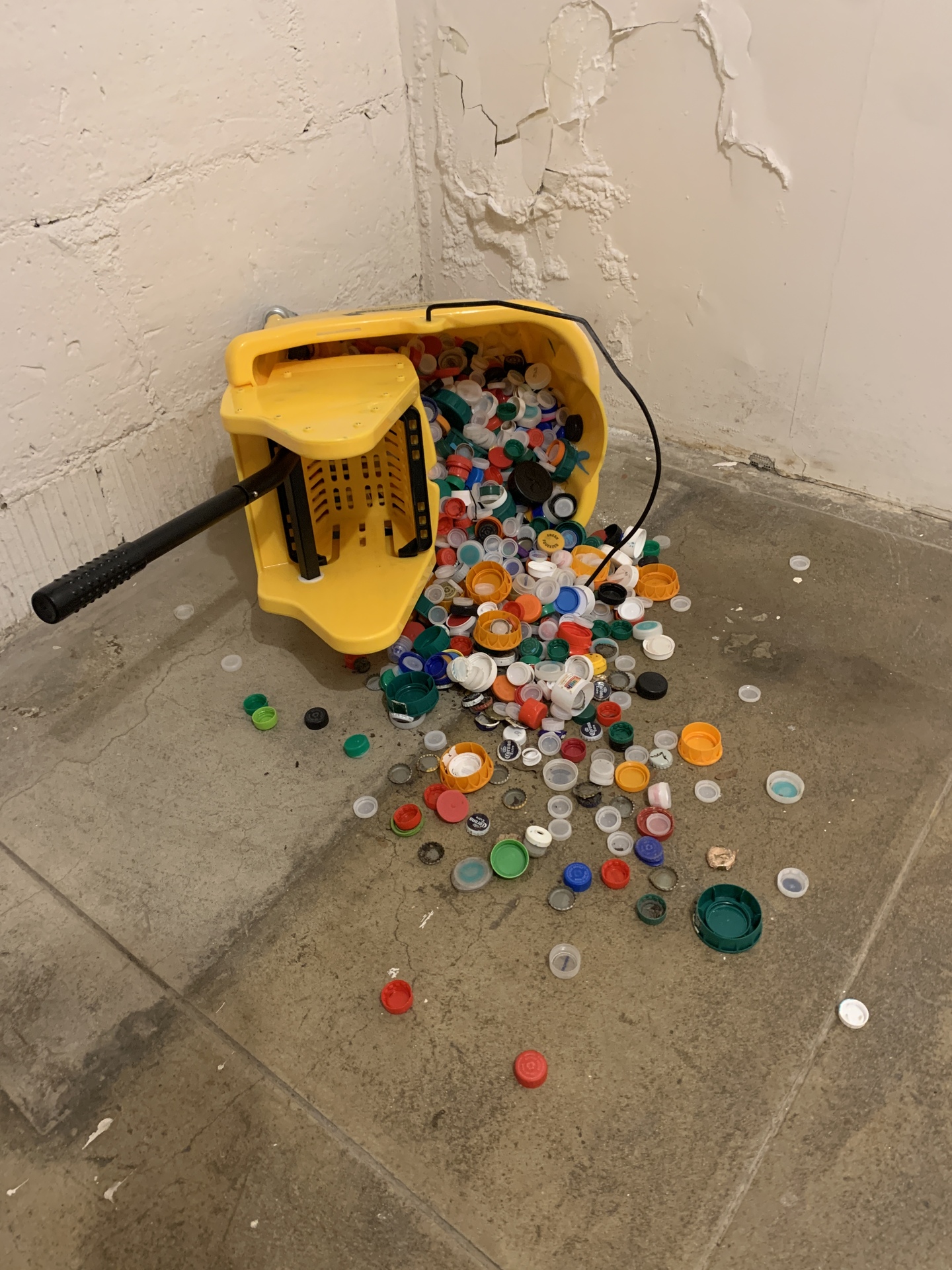 Harrison Brisbon-McKinnon • Bottom Feeder I • Collected Trash • 36” x 36” • Poughkeepsie, NY • NFS • This piece represents the responsibility that people should have with their own creations. We make waste that can easily spread and create chaos around the area, but we must take responsibility and clean our mess. This piece is a plastic mop bucket full of plastic trash; the trash can be knocked over but the litterer is obligated to clean after themselves. The title “Bottom Feeder” further represents this by helping one think of what we are making ourselves when choosing to live in our own filth.
Harrison Brisbon-McKinnon • Bottom Feeder I • Collected Trash • 36” x 36” • Poughkeepsie, NY • NFS • This piece represents the responsibility that people should have with their own creations. We make waste that can easily spread and create chaos around the area, but we must take responsibility and clean our mess. This piece is a plastic mop bucket full of plastic trash; the trash can be knocked over but the litterer is obligated to clean after themselves. The title “Bottom Feeder” further represents this by helping one think of what we are making ourselves when choosing to live in our own filth.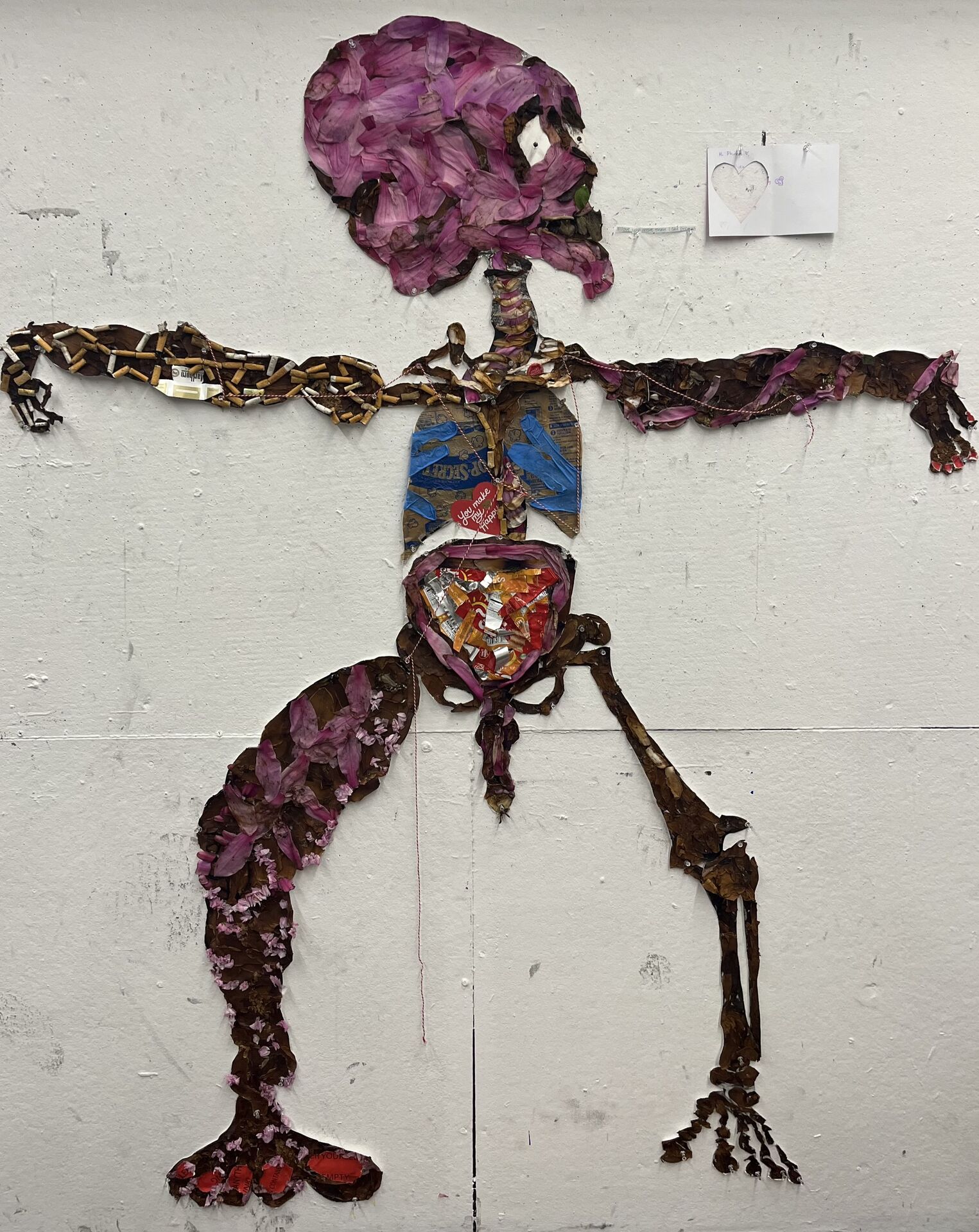 Phineas Cashman • 罪人的解剖:腐烂 (anatomy of a sinner: decay) • ink, charcoal, and found objects on paper • 70” x 36” • Worcester, MA • NFS • This work will constantly decay over time. The artist has revived the work for this exhibition so the changes and disintegration of the work will be more observable - the work will slowly die adn fall apart over the length of the exhibition. Cashman displays all the horrible things we consume then dispose of. We’re slowly killing ourselves and the Earth from the inside, hence the name of this piece: “anatomy of a sinner: decay”.
Phineas Cashman • 罪人的解剖:腐烂 (anatomy of a sinner: decay) • ink, charcoal, and found objects on paper • 70” x 36” • Worcester, MA • NFS • This work will constantly decay over time. The artist has revived the work for this exhibition so the changes and disintegration of the work will be more observable - the work will slowly die adn fall apart over the length of the exhibition. Cashman displays all the horrible things we consume then dispose of. We’re slowly killing ourselves and the Earth from the inside, hence the name of this piece: “anatomy of a sinner: decay”. Gail Chapman • Rising Water • Clay • 7” 27” 12” • Philadelphia, PA • $450 • Chapman is a person that loves to work with the environment around them. Clay is one of the artist’s favorite materials because she enjoys working with her hands. In “Rising Water” the water appears suspended between ebbing up and flowing away. It is inspired by decay and erosion.The artist is referencing the impact that climate change has on the planet - gentle and destructive.
Gail Chapman • Rising Water • Clay • 7” 27” 12” • Philadelphia, PA • $450 • Chapman is a person that loves to work with the environment around them. Clay is one of the artist’s favorite materials because she enjoys working with her hands. In “Rising Water” the water appears suspended between ebbing up and flowing away. It is inspired by decay and erosion.The artist is referencing the impact that climate change has on the planet - gentle and destructive.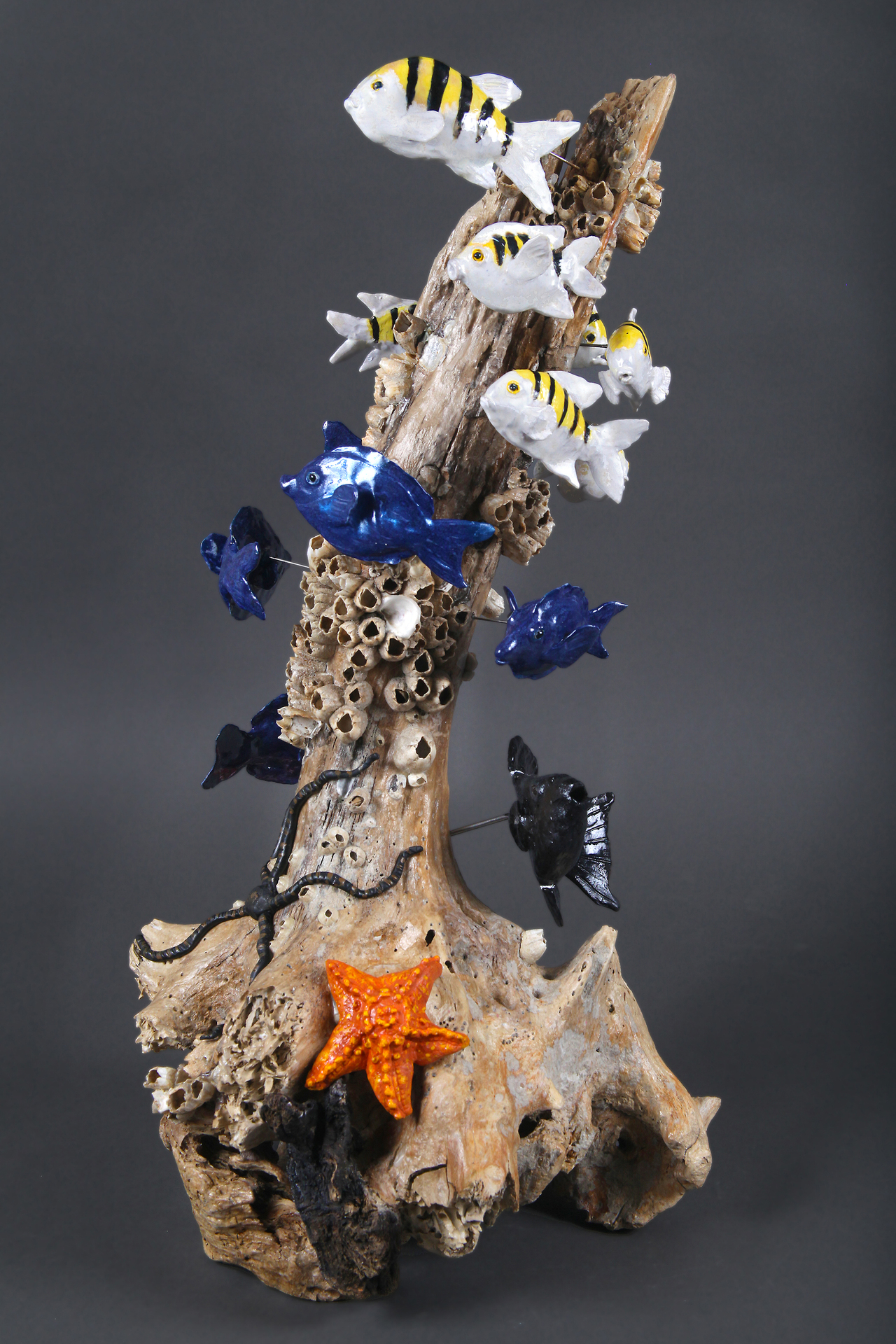 Grace Davies • Reef Fish • Ceramic, wood, wire, epoxy resin • 24” x 12” x 12” • Brooklyn, NY • $1,000 • Davis uses recycled and discarded materials whenever possible. Using them for these sculptures as a reminder of what we are losing and what that could lead to. "Reef Fish" represents ecosystems that have been in constant danger. While on the other side is "Camelaffe," a representation of what that could lead to with all ecosystems endangered. A look into the future of the loss of animals, ecosystems, and the dystopian path humanity could take with the loss of vital resources.
Grace Davies • Reef Fish • Ceramic, wood, wire, epoxy resin • 24” x 12” x 12” • Brooklyn, NY • $1,000 • Davis uses recycled and discarded materials whenever possible. Using them for these sculptures as a reminder of what we are losing and what that could lead to. "Reef Fish" represents ecosystems that have been in constant danger. While on the other side is "Camelaffe," a representation of what that could lead to with all ecosystems endangered. A look into the future of the loss of animals, ecosystems, and the dystopian path humanity could take with the loss of vital resources.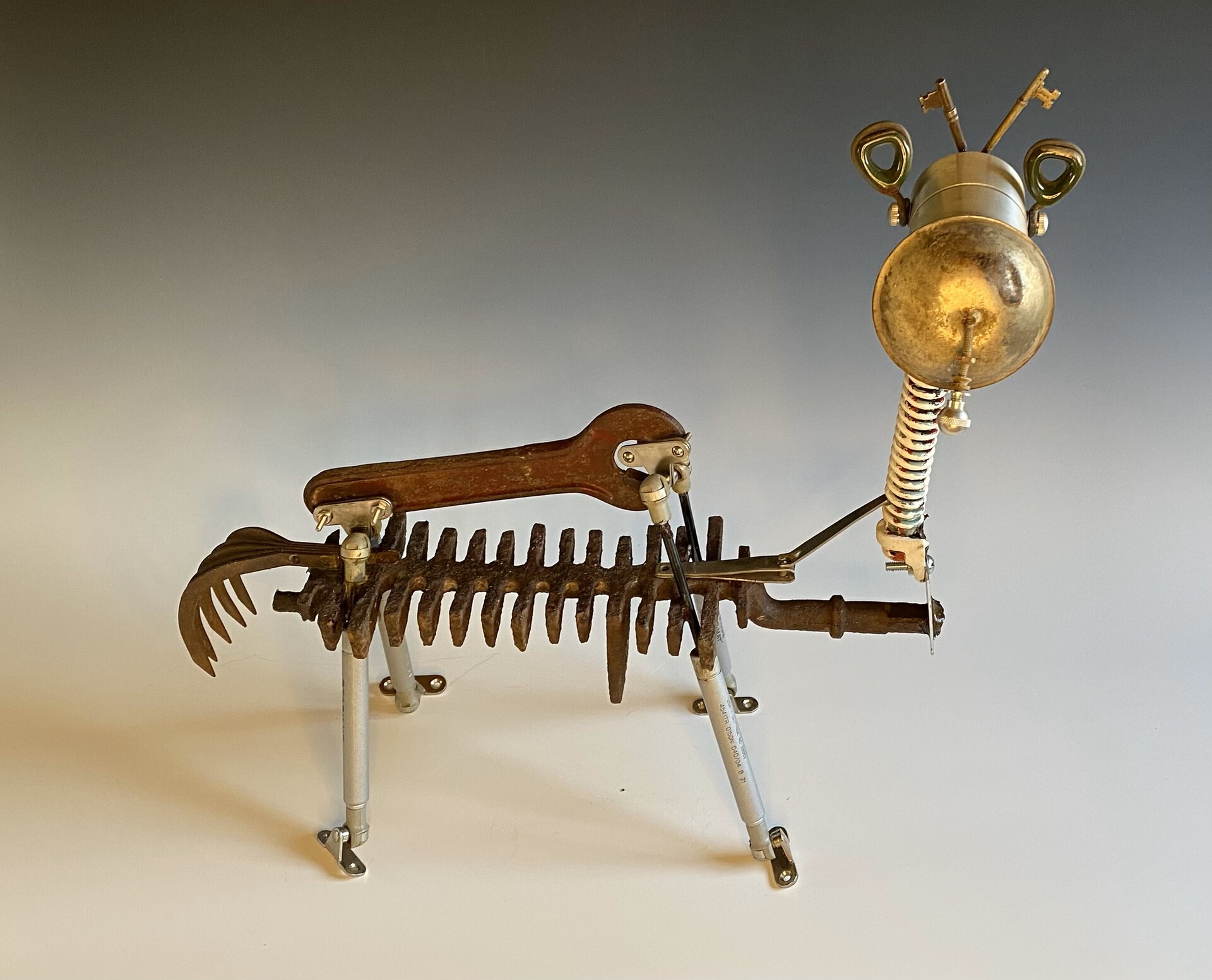 Grace Davies • Camelaffe • Scrap metal • 12” x 15” x 5” • Brooklyn, NY • $500 • Davis uses recycled and discarded materials whenever possible. Using them for these sculptures as a reminder of what we are losing and what that could lead to. "Reef Fish" represents ecosystems that have been in constant danger. While on the other side is "Camelaffe," a representation of what that could lead to with all ecosystems endangered. A look into the future of the loss of animals, ecosystems, and the dystopian path humanity could take with the loss of vital resources.
Grace Davies • Camelaffe • Scrap metal • 12” x 15” x 5” • Brooklyn, NY • $500 • Davis uses recycled and discarded materials whenever possible. Using them for these sculptures as a reminder of what we are losing and what that could lead to. "Reef Fish" represents ecosystems that have been in constant danger. While on the other side is "Camelaffe," a representation of what that could lead to with all ecosystems endangered. A look into the future of the loss of animals, ecosystems, and the dystopian path humanity could take with the loss of vital resources.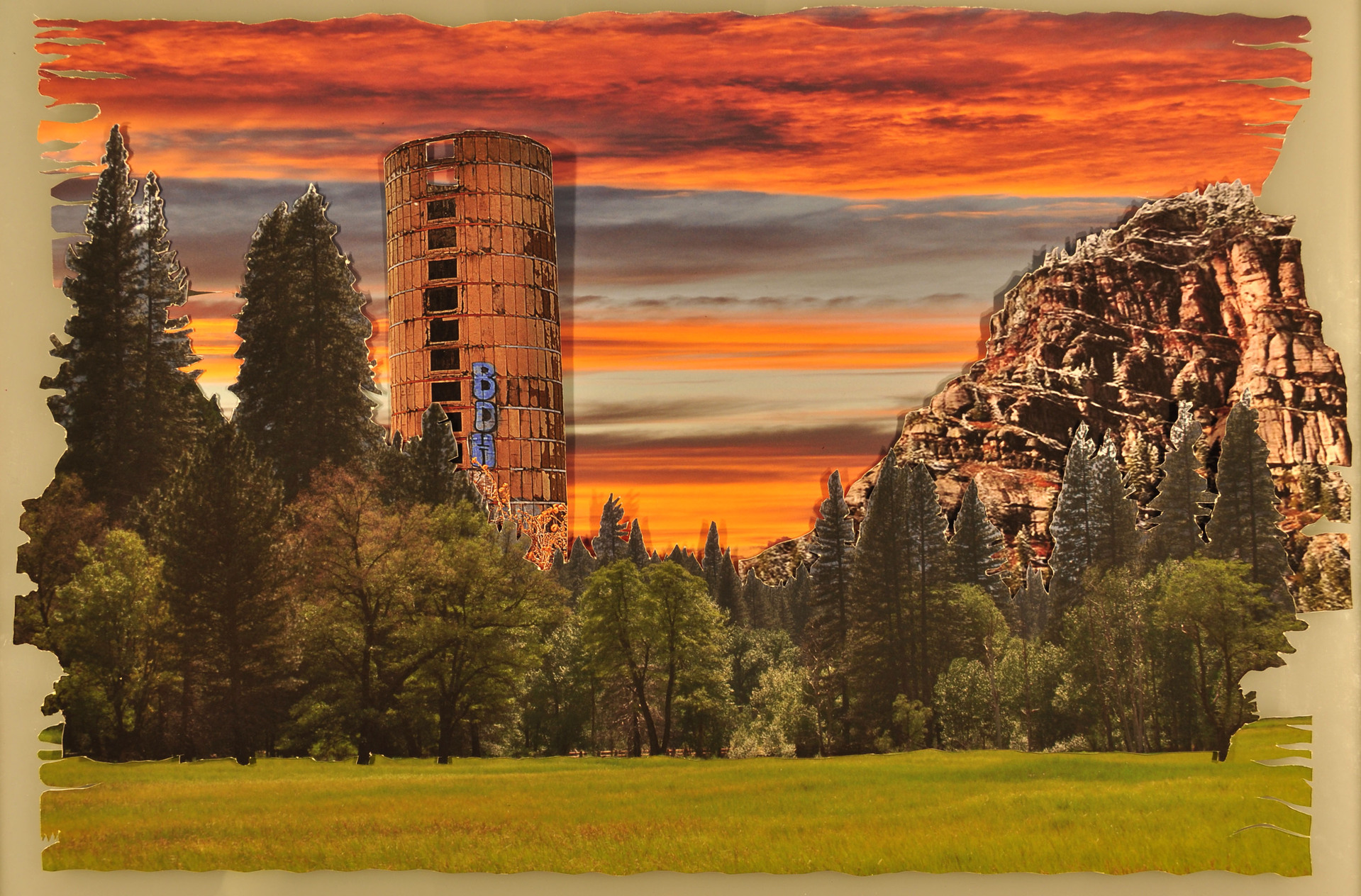 Amy DiMare • Removing the Residue of Yesterday's Existence • Layered InkJet print • 17” x 22” • Moab, UT • $650 • Over time silos can mold and decay; it's a finite balance that must be maintained otherwise it can collapse, fold over, and decay and mold away. In Removing the Residue of Yesterday's Existence DiMare places the remnants of human construction in the background and depicts the planet's future in the foreground with the overgrowth of tomorrow.
Amy DiMare • Removing the Residue of Yesterday's Existence • Layered InkJet print • 17” x 22” • Moab, UT • $650 • Over time silos can mold and decay; it's a finite balance that must be maintained otherwise it can collapse, fold over, and decay and mold away. In Removing the Residue of Yesterday's Existence DiMare places the remnants of human construction in the background and depicts the planet's future in the foreground with the overgrowth of tomorrow. Serena Domingues • Interruption • Multi-media ( video, found objects, metal, plants, wood) • 5’ x 5’ x 3’ • LaGrangeville, NY • NFS • This work gives you multiple perspectives of a single video using obsolete viewing technology. Some TVs have devolved to the point where nature has reclaimed them entirely. Domingues seeks “to reconcile our modern existence with the ecological balance we've disrupted.” With all these different vantage points, the artist begs the question “Why watch so many views of nature when you can go outside and experience it yourself?”
Serena Domingues • Interruption • Multi-media ( video, found objects, metal, plants, wood) • 5’ x 5’ x 3’ • LaGrangeville, NY • NFS • This work gives you multiple perspectives of a single video using obsolete viewing technology. Some TVs have devolved to the point where nature has reclaimed them entirely. Domingues seeks “to reconcile our modern existence with the ecological balance we've disrupted.” With all these different vantage points, the artist begs the question “Why watch so many views of nature when you can go outside and experience it yourself?”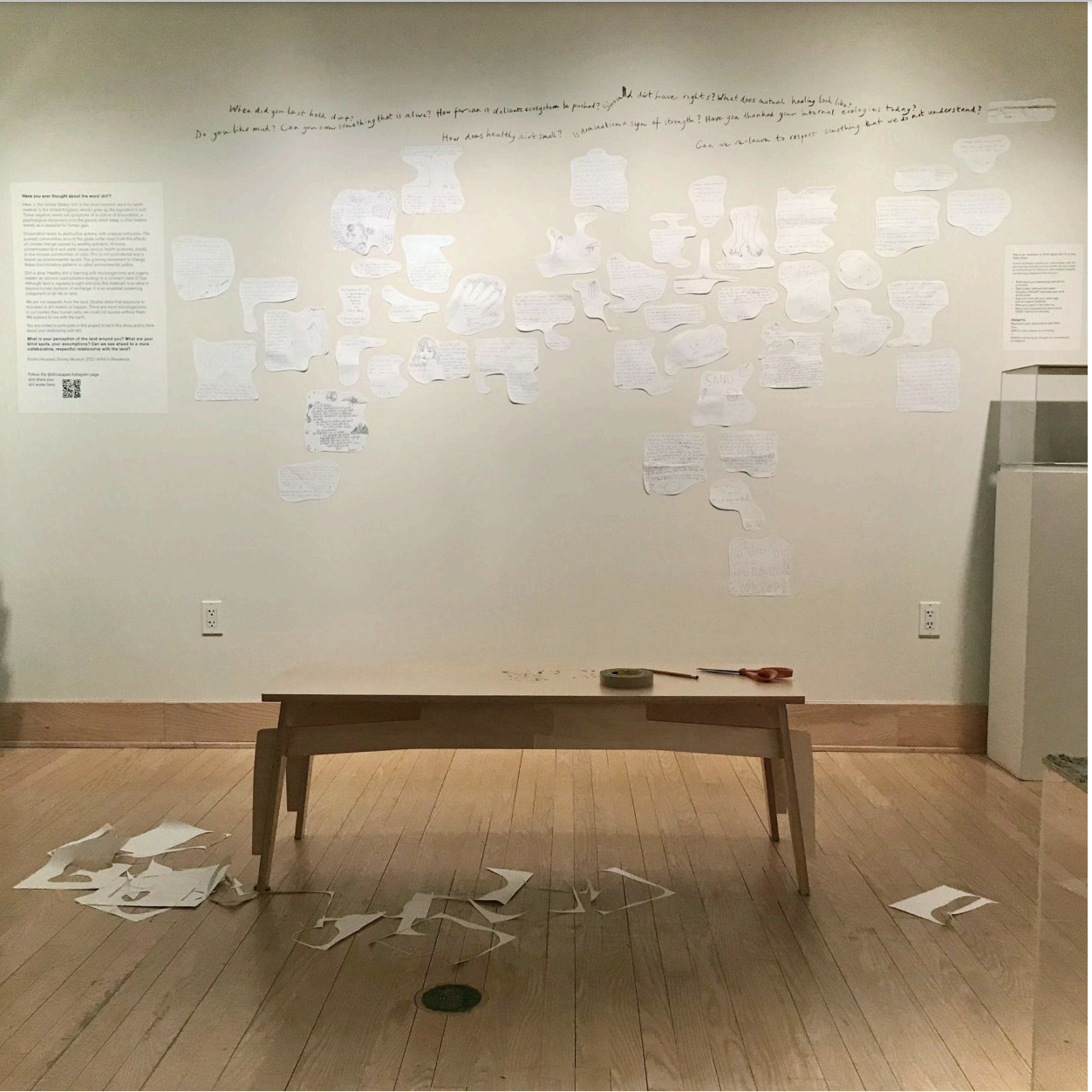 The DIRT Project • Trolley Barn DIRT organism • Interactive Wall Installation • 80” x 120” • New Paltz, NY • NFS • The DIRT Project invites viewers to examine their own positionalities and psyches within the climate crisis. How does one reimagine the systems we inherit that are rooted in the devaluation and exploitation of the land? Through the interactive exhibition, the project seeks to slow down the transactional relationship we are forced into with land, natural resources, and dirt itself to reimagine a connection based on reciprocity and care with the land that nourishes us. Take a minute, think, and imagine the future world you wish to live in.
The DIRT Project • Trolley Barn DIRT organism • Interactive Wall Installation • 80” x 120” • New Paltz, NY • NFS • The DIRT Project invites viewers to examine their own positionalities and psyches within the climate crisis. How does one reimagine the systems we inherit that are rooted in the devaluation and exploitation of the land? Through the interactive exhibition, the project seeks to slow down the transactional relationship we are forced into with land, natural resources, and dirt itself to reimagine a connection based on reciprocity and care with the land that nourishes us. Take a minute, think, and imagine the future world you wish to live in. Jenniffer Farley • Come sit with me beneath the willow tree • Linocut • 18” x 12” x 12” • Orem, UT • $400 • Farley’s prints focus on offering new perspectives of natural phenomena, creating dynamic compositions that ask the viewer to think about the complexity and interconnectedness of themselves and the world around them. In Come sit with me beneath the willow tree, Farley chose to depict a beautiful tree that lives far beyond the people who plant them. Willows are the monument and testament of the strength and gentleness of the earth. They have long branches that can grow into even stronger trees once they pass. This endurance is another testament to the hidden powers of the earth.
Jenniffer Farley • Come sit with me beneath the willow tree • Linocut • 18” x 12” x 12” • Orem, UT • $400 • Farley’s prints focus on offering new perspectives of natural phenomena, creating dynamic compositions that ask the viewer to think about the complexity and interconnectedness of themselves and the world around them. In Come sit with me beneath the willow tree, Farley chose to depict a beautiful tree that lives far beyond the people who plant them. Willows are the monument and testament of the strength and gentleness of the earth. They have long branches that can grow into even stronger trees once they pass. This endurance is another testament to the hidden powers of the earth.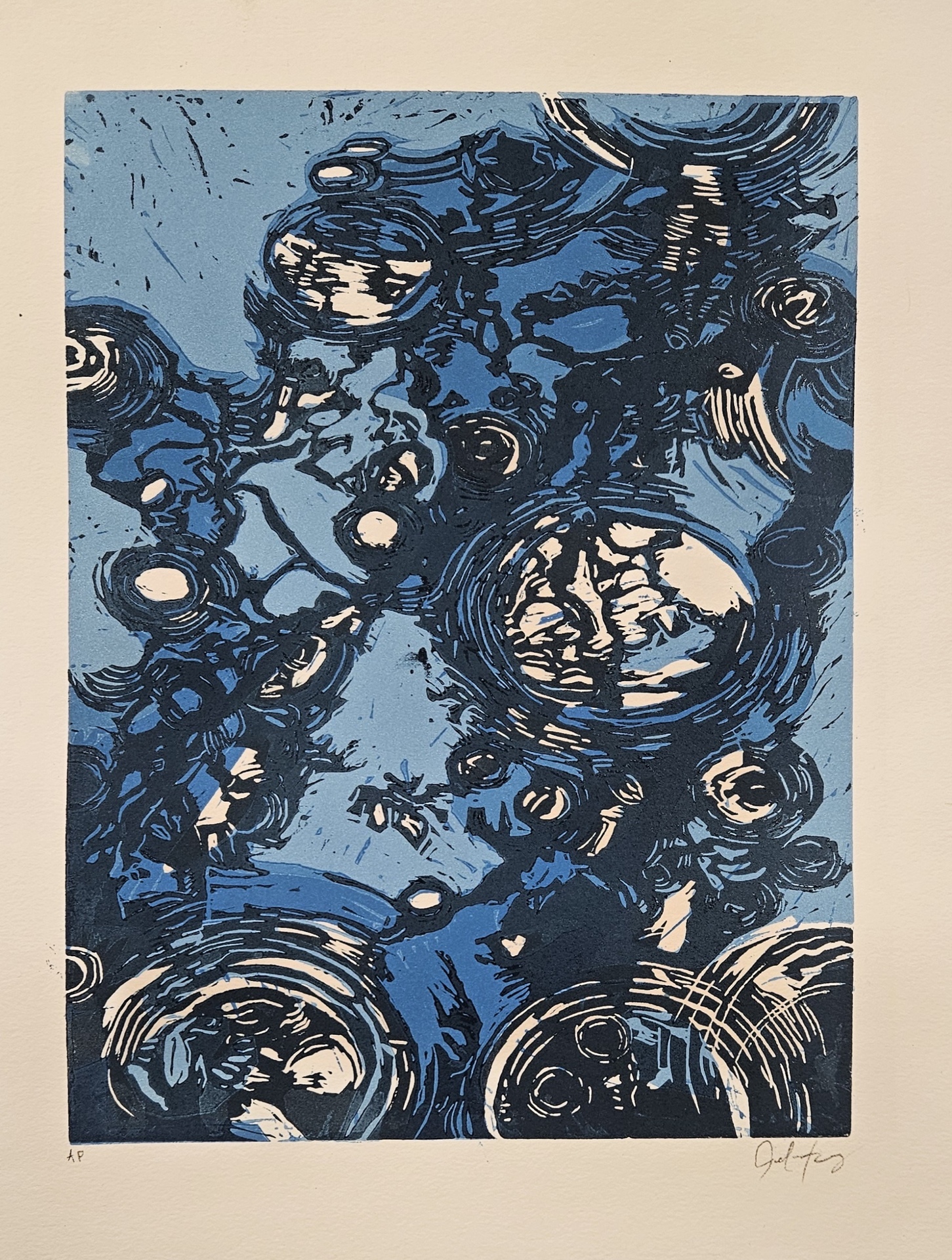 Jenniffer Farley • This Keeps Happening • Reduction relief • 12” x 9” • Orem, UT • $100 • Farley’s prints focus on offering new perspectives of natural phenomena, creating dynamic compositions that ask the viewer to think about the complexity and interconnectedness of themselves and the world around them. This Keeps Happening captures the fleeting moments of raindrops hitting the ground. Blotches of blue flow throughout the reductive print, the rain flourishing in ripples that contain the movements of abstraction. This replenishing of the Earth, purifying and washing away impurities, signifies the Earth's replenishing itself from toxins.
Jenniffer Farley • This Keeps Happening • Reduction relief • 12” x 9” • Orem, UT • $100 • Farley’s prints focus on offering new perspectives of natural phenomena, creating dynamic compositions that ask the viewer to think about the complexity and interconnectedness of themselves and the world around them. This Keeps Happening captures the fleeting moments of raindrops hitting the ground. Blotches of blue flow throughout the reductive print, the rain flourishing in ripples that contain the movements of abstraction. This replenishing of the Earth, purifying and washing away impurities, signifies the Earth's replenishing itself from toxins.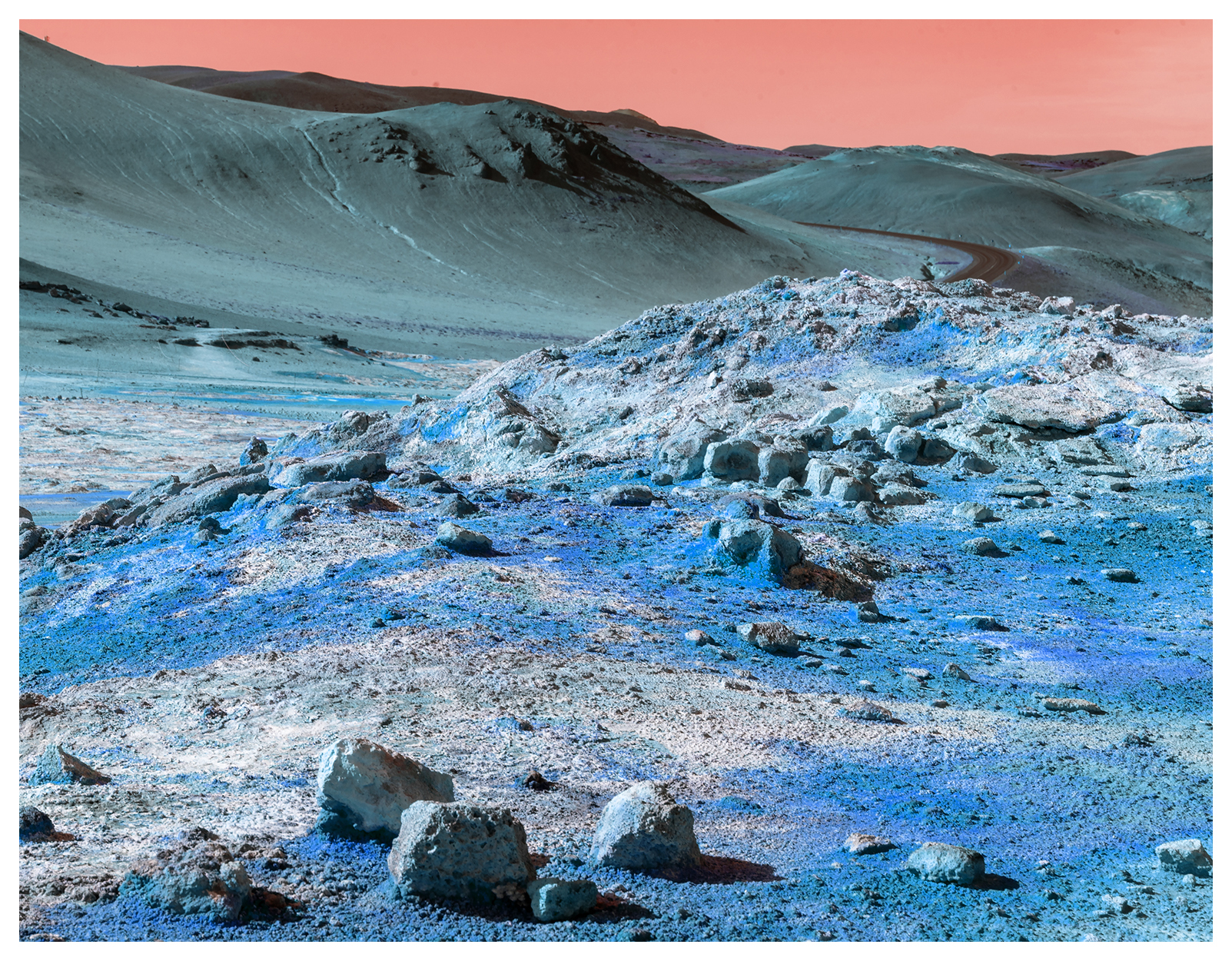 Erica Frisk • Decisions for Eternity • Archival Inkjet Print • 20” x 24” • Somerville, MA • $500 • These otherworldly images are disturbing and fantastic. They are images of Earth, taken around the globe for a 2021 series, “The Terra Series”, which “showcases scenery that is distorted, unknown and mysterious”. The artist is fascinated by how little we know about time, space and our futures and revels in the knowledge that no matter how much we imagine, we are still tethered to this Planet and our own experiences.
Erica Frisk • Decisions for Eternity • Archival Inkjet Print • 20” x 24” • Somerville, MA • $500 • These otherworldly images are disturbing and fantastic. They are images of Earth, taken around the globe for a 2021 series, “The Terra Series”, which “showcases scenery that is distorted, unknown and mysterious”. The artist is fascinated by how little we know about time, space and our futures and revels in the knowledge that no matter how much we imagine, we are still tethered to this Planet and our own experiences.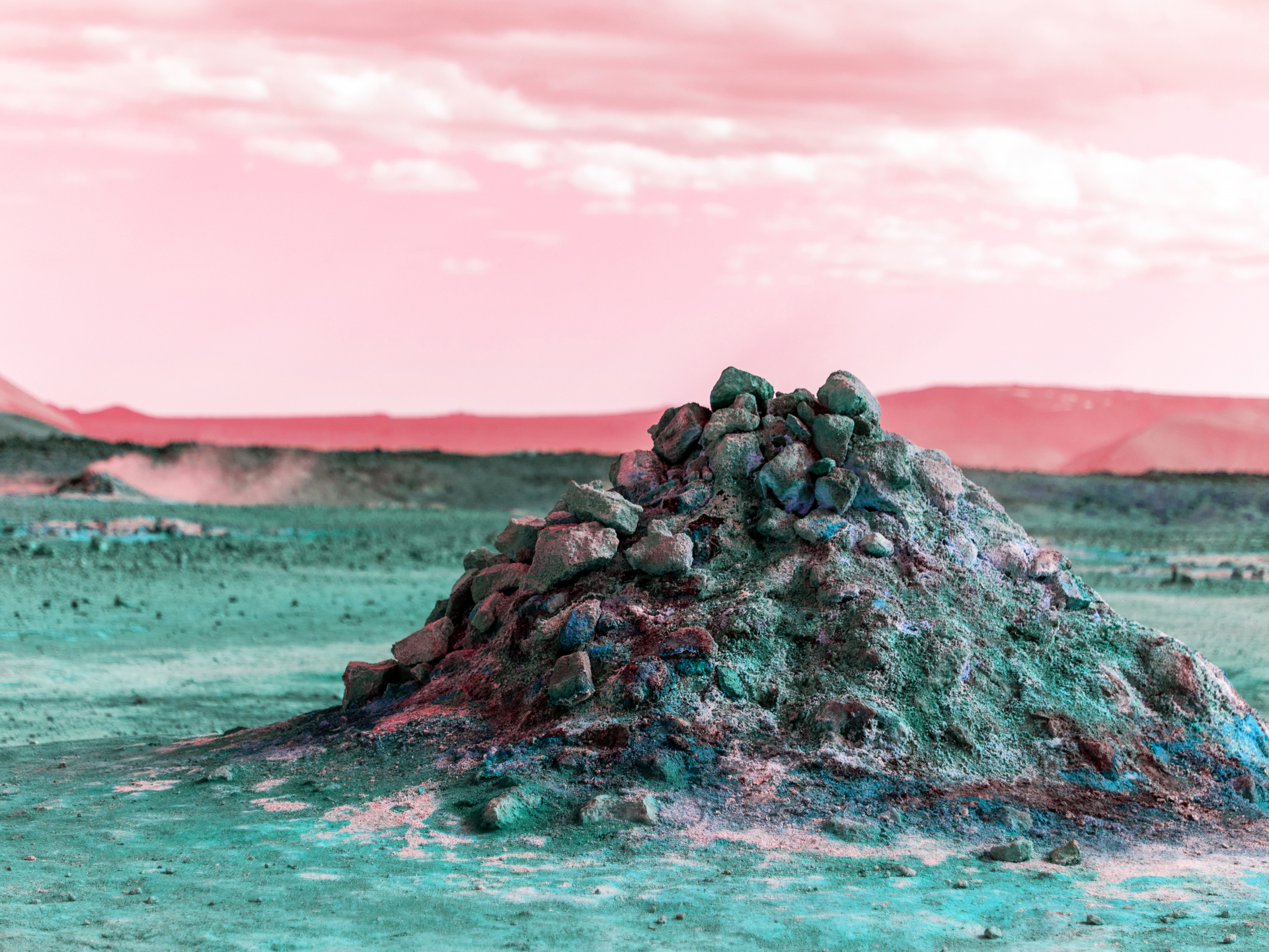 Erica Frisk • Mysterious Mound • Archival Inkjet Print • 20” x 24” • Somerville, MA • $500 • These otherworldly images are disturbing and fantastic. They are images of Earth, taken around the globe for a 2021 series, “The Terra Series”, which “showcases scenery that is distorted, unknown and mysterious”. The artist is fascinated by how little we know about time, space and our futures and revels in the knowledge that no matter how much we imagine, we are still tethered to this Planet and our own experiences.
Erica Frisk • Mysterious Mound • Archival Inkjet Print • 20” x 24” • Somerville, MA • $500 • These otherworldly images are disturbing and fantastic. They are images of Earth, taken around the globe for a 2021 series, “The Terra Series”, which “showcases scenery that is distorted, unknown and mysterious”. The artist is fascinated by how little we know about time, space and our futures and revels in the knowledge that no matter how much we imagine, we are still tethered to this Planet and our own experiences.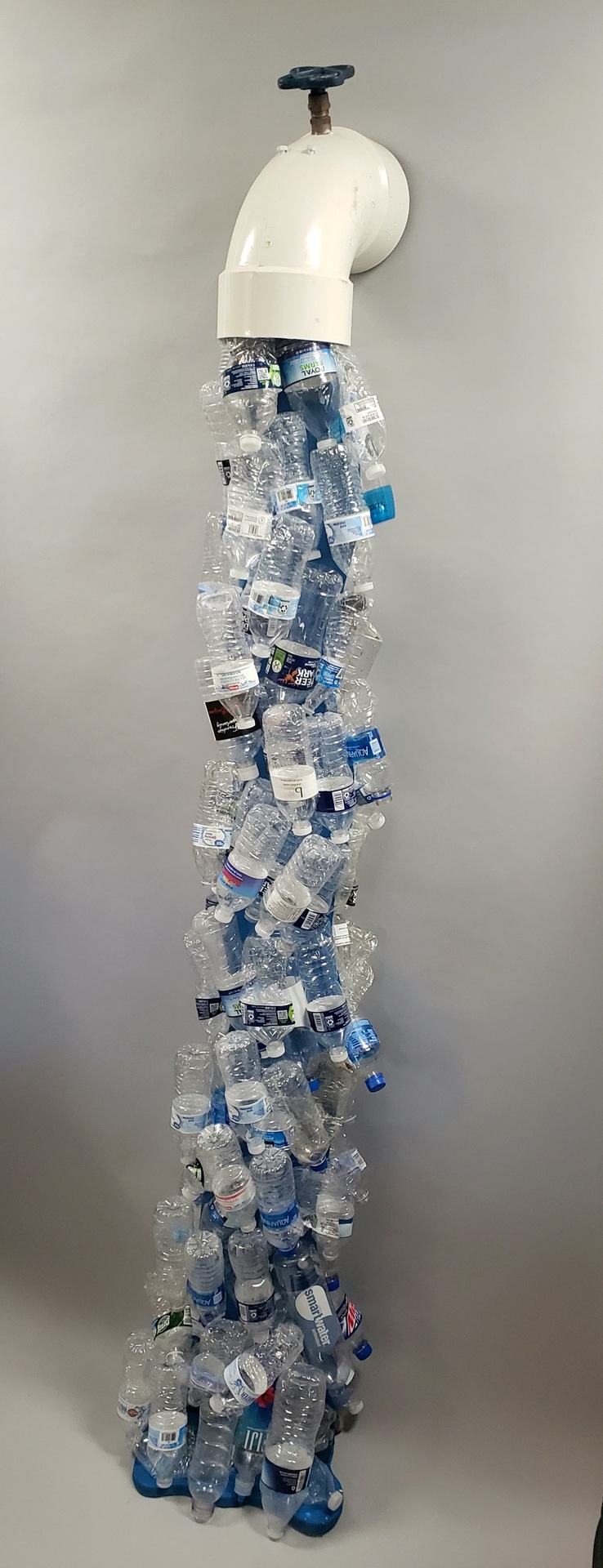 nic galloro • Cut the Flow of single-use plastic water bottles • Mixed media - found objects • 77” x 15” x 12” • Havre de Grace, MD • $1,200 • Macroplastics abound! Single-use water bottles tumble in a seemingly unstoppable flow out of the faucet in the wall. Water is so important to us all as a vital component of life and survival, but our use of this unending tide of plastics is contributing to a toxic imbalance in our water.
nic galloro • Cut the Flow of single-use plastic water bottles • Mixed media - found objects • 77” x 15” x 12” • Havre de Grace, MD • $1,200 • Macroplastics abound! Single-use water bottles tumble in a seemingly unstoppable flow out of the faucet in the wall. Water is so important to us all as a vital component of life and survival, but our use of this unending tide of plastics is contributing to a toxic imbalance in our water.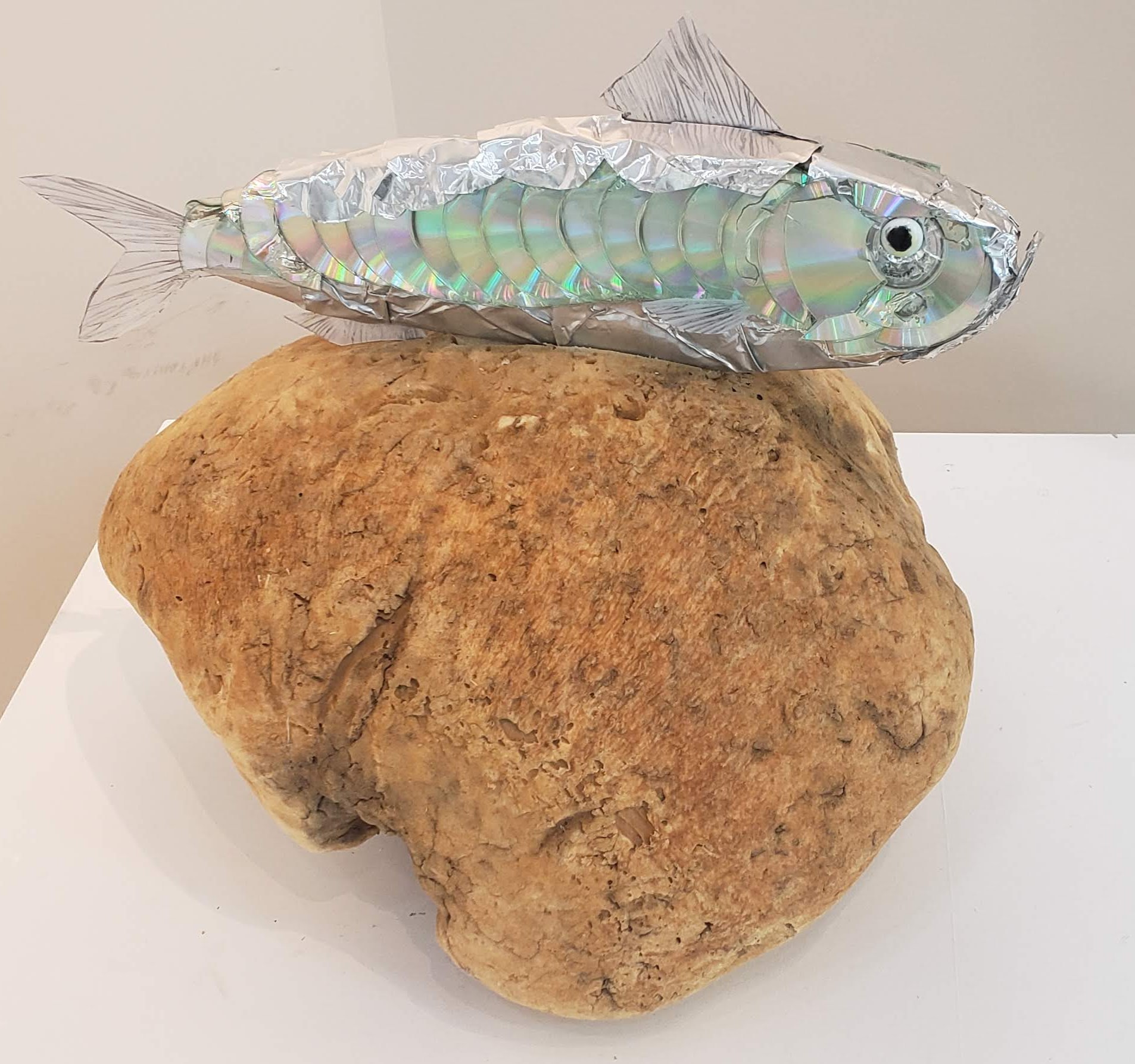 nic galloro • Foamberg Fish • Mixed media - found objects • 20” x 20” x 14” • Havre de Grace, MD • $315 • The Susquehanna River runs by Galloro's home and a piece of foam he found floating along it serves as the base of his piece. Functionally it supports a fish constructed of CDs, aluminum foil, and wood. Conceptually it pulls us to think about how along with the materials that create the fish, this foam is part of the modern environment that fish and other aquatic animals must inhabit and navigate.
nic galloro • Foamberg Fish • Mixed media - found objects • 20” x 20” x 14” • Havre de Grace, MD • $315 • The Susquehanna River runs by Galloro's home and a piece of foam he found floating along it serves as the base of his piece. Functionally it supports a fish constructed of CDs, aluminum foil, and wood. Conceptually it pulls us to think about how along with the materials that create the fish, this foam is part of the modern environment that fish and other aquatic animals must inhabit and navigate.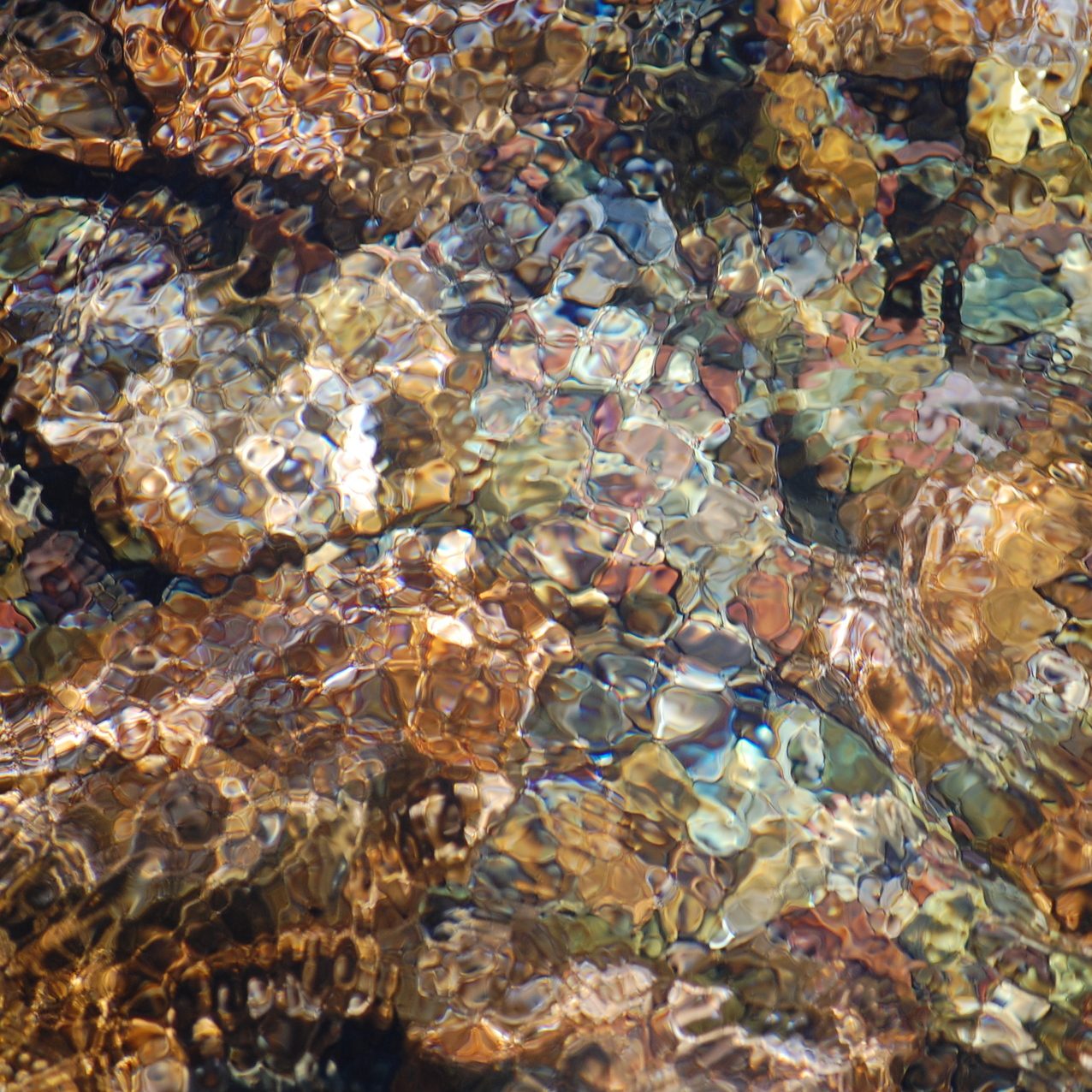 Ilene Gold • Leaves in the Stream • Photography • 12.5” x 15.5” • Baltimore, MD • $125 • This is a reflection. One piece, "Reflections in Paris", is a reflection of the work humans have done to make the Earth livable and comfortable. The other piece, "Leaves in the Stream'', is a reflection of the Earth and what the planet has done to make itself livable and comfortable. Gold highlights how humans refract their environment - distorting the beauty of nature to make it more orderly and segregated from its Earthly inspiration. Windows reflect more windows, more buildings, more people; while the water reflects the Sun.
Ilene Gold • Leaves in the Stream • Photography • 12.5” x 15.5” • Baltimore, MD • $125 • This is a reflection. One piece, "Reflections in Paris", is a reflection of the work humans have done to make the Earth livable and comfortable. The other piece, "Leaves in the Stream'', is a reflection of the Earth and what the planet has done to make itself livable and comfortable. Gold highlights how humans refract their environment - distorting the beauty of nature to make it more orderly and segregated from its Earthly inspiration. Windows reflect more windows, more buildings, more people; while the water reflects the Sun.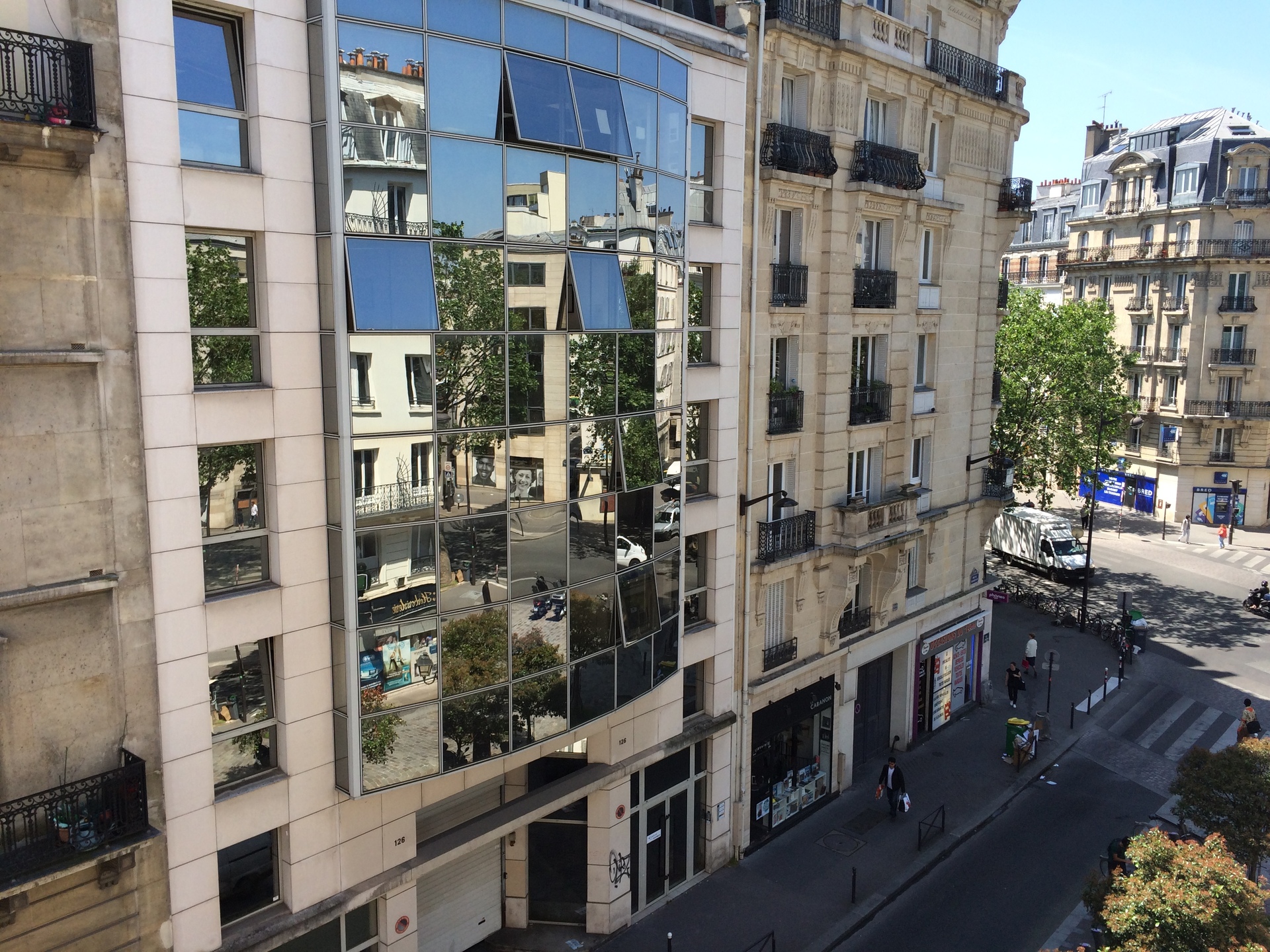 Ilene Gold • Reflections in Paris • Photography • 12.5” x 15.5” • Baltimore, MD • $125 • This is a reflection. One piece, "Reflections in Paris", is a reflection of the work humans have done to make the Earth livable and comfortable. The other piece, "Leaves in the Stream'', is a reflection of the Earth and what the planet has done to make itself livable and comfortable. Gold highlights how humans refract their environment - distorting the beauty of nature to make it more orderly and segregated from its Earthly inspiration. Windows reflect more windows, more buildings, more people; while the water reflects the Sun.
Ilene Gold • Reflections in Paris • Photography • 12.5” x 15.5” • Baltimore, MD • $125 • This is a reflection. One piece, "Reflections in Paris", is a reflection of the work humans have done to make the Earth livable and comfortable. The other piece, "Leaves in the Stream'', is a reflection of the Earth and what the planet has done to make itself livable and comfortable. Gold highlights how humans refract their environment - distorting the beauty of nature to make it more orderly and segregated from its Earthly inspiration. Windows reflect more windows, more buildings, more people; while the water reflects the Sun.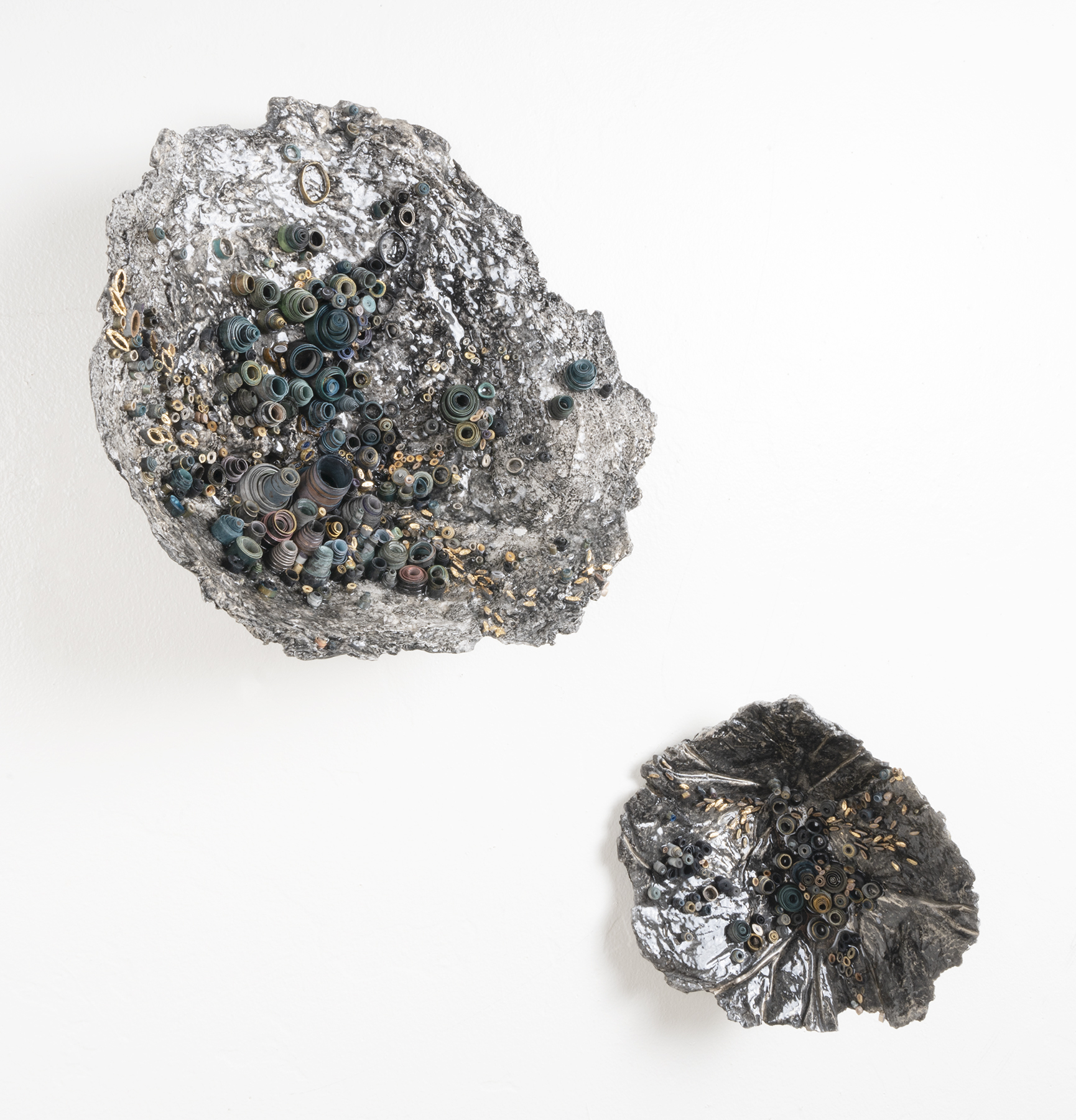 Danielle Jones • Slowly Rapid • Handmade paper, ink, Mississippi River water, resin • 10.5” 12” x 16” • Tucson, AZ • $3,000 • Jones works in deconstructed materials like paper - exploring themes of protection, strength, and vulnerability. Through turning this delicate material (one easily ripped and torn into a strong piece), Jones touches on the cycles of preparation, breaking, and mending - a cycle that is never finished. As water levels rise and storms become more frequent, the cycle is becoming shorter and shorter - but it is after the disaster that we can recover and create something anew. "Slowly Rapid" glimmers with the possibility of breaking beyond the boundaries and imagining a politics of repair and renewal.
Danielle Jones • Slowly Rapid • Handmade paper, ink, Mississippi River water, resin • 10.5” 12” x 16” • Tucson, AZ • $3,000 • Jones works in deconstructed materials like paper - exploring themes of protection, strength, and vulnerability. Through turning this delicate material (one easily ripped and torn into a strong piece), Jones touches on the cycles of preparation, breaking, and mending - a cycle that is never finished. As water levels rise and storms become more frequent, the cycle is becoming shorter and shorter - but it is after the disaster that we can recover and create something anew. "Slowly Rapid" glimmers with the possibility of breaking beyond the boundaries and imagining a politics of repair and renewal.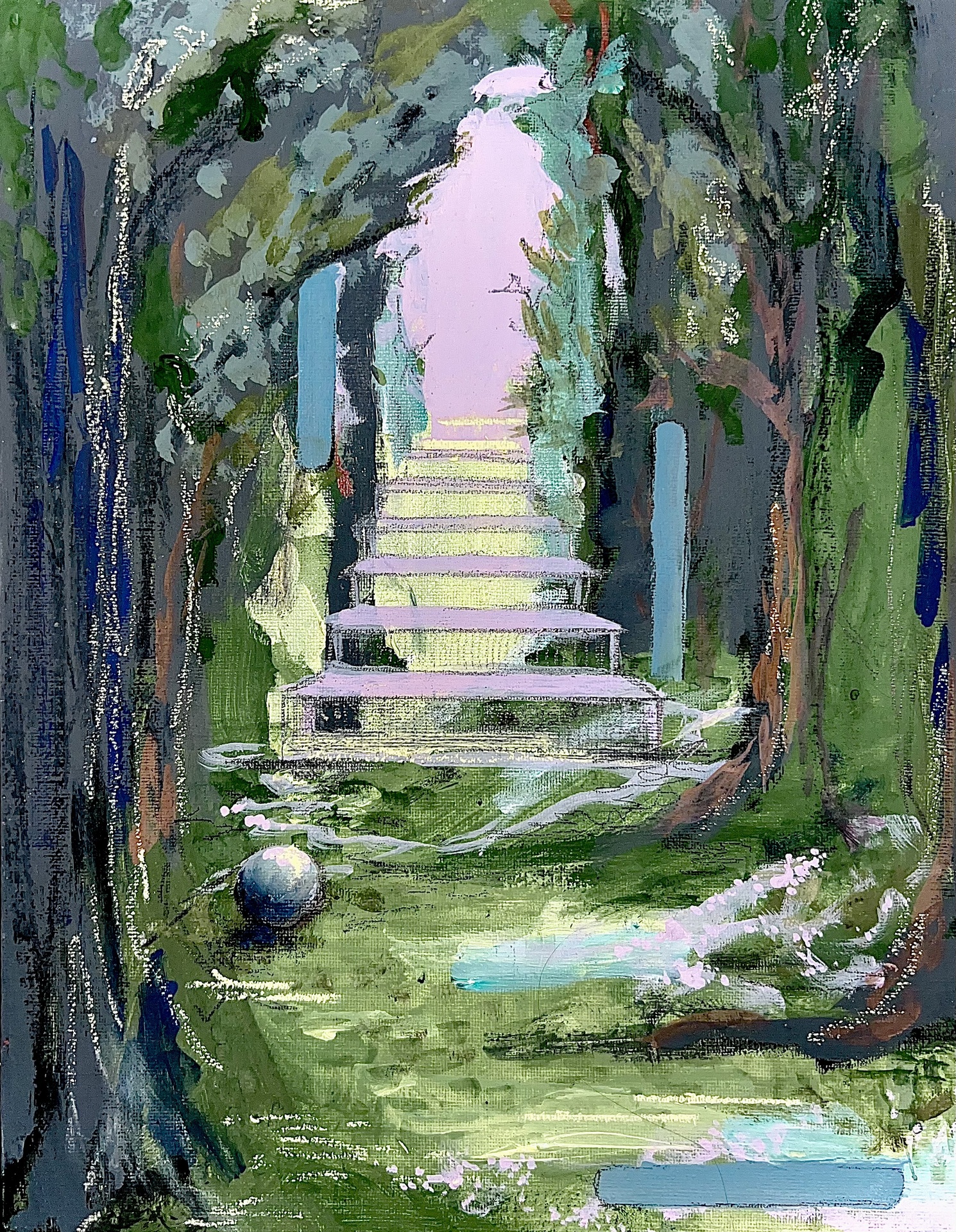 emily koch • In The Slithy Toves • Acrylic, oil pastel and charcoal on paper • 44” x 34” • Newton, MA • $770 • Koch's images give the aura of a darker toned mythology based wonderland. Holding similarities in color and imagery, the archways in both "Mone Rath" & " The Slithy Toves" seem like open passageways to "Untitled." This trio gives a familiar yet somber feeling, much like the double nature of the two-Headed God Janus of Greek mythos. He looks over passages like the ones that accompany the two-headed woman of "Untitled."
emily koch • In The Slithy Toves • Acrylic, oil pastel and charcoal on paper • 44” x 34” • Newton, MA • $770 • Koch's images give the aura of a darker toned mythology based wonderland. Holding similarities in color and imagery, the archways in both "Mone Rath" & " The Slithy Toves" seem like open passageways to "Untitled." This trio gives a familiar yet somber feeling, much like the double nature of the two-Headed God Janus of Greek mythos. He looks over passages like the ones that accompany the two-headed woman of "Untitled."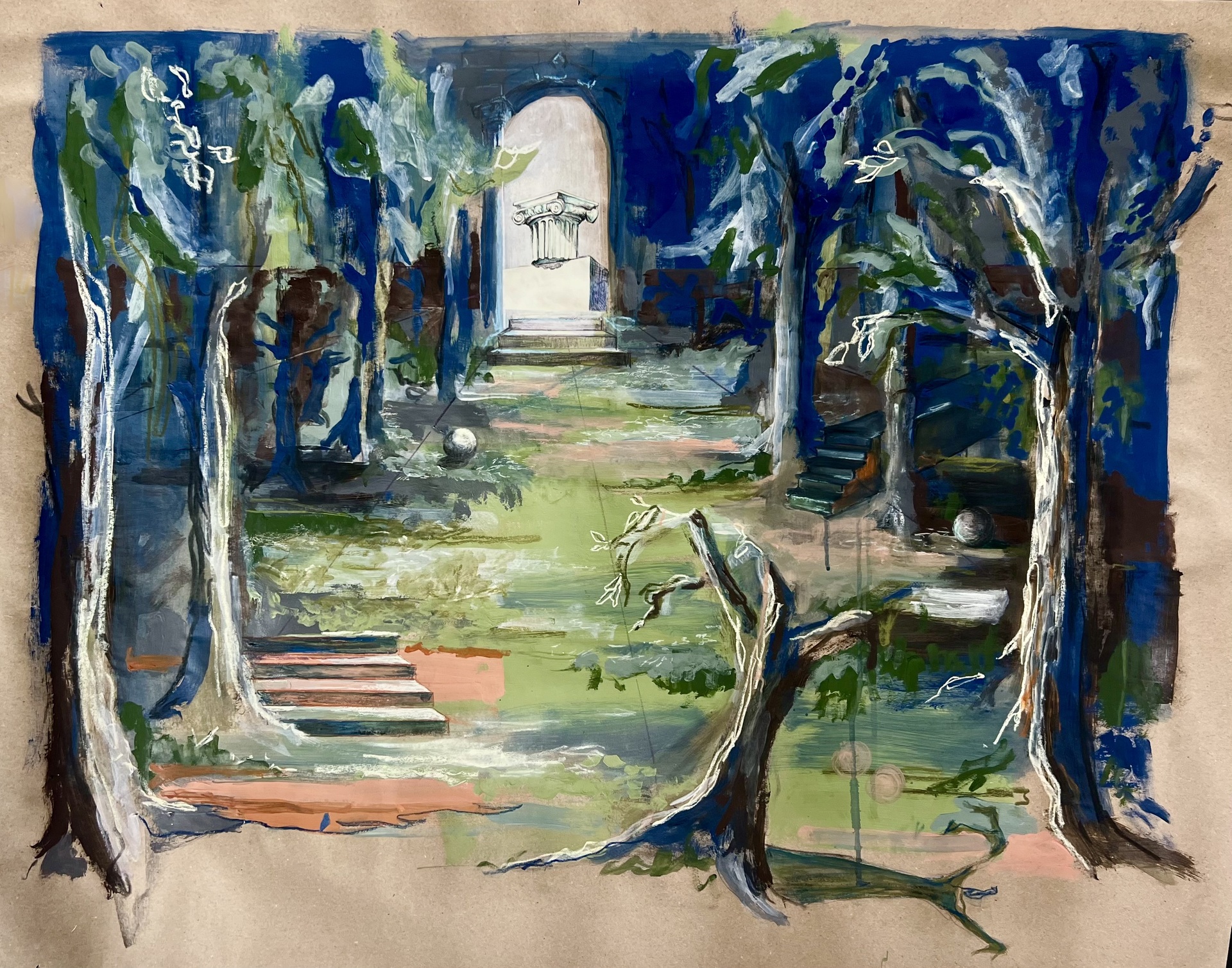 emily koch • Mome Raths • Acrylic, pastel and charcoal on canvas board • 14” x 11” • Newton, MA • $310 • Koch's images give the aura of a darker toned mythology based wonderland. Holding similarities in color and imagery, the archways in both "Mone Rath" & " The Slithy Toves" seem like open passageways to "Untitled." This trio gives a familiar yet somber feeling, much like the double nature of the two-Headed God Janus of Greek mythos. He looks over passages like the ones that accompany the two-headed woman of "Untitled."
emily koch • Mome Raths • Acrylic, pastel and charcoal on canvas board • 14” x 11” • Newton, MA • $310 • Koch's images give the aura of a darker toned mythology based wonderland. Holding similarities in color and imagery, the archways in both "Mone Rath" & " The Slithy Toves" seem like open passageways to "Untitled." This trio gives a familiar yet somber feeling, much like the double nature of the two-Headed God Janus of Greek mythos. He looks over passages like the ones that accompany the two-headed woman of "Untitled."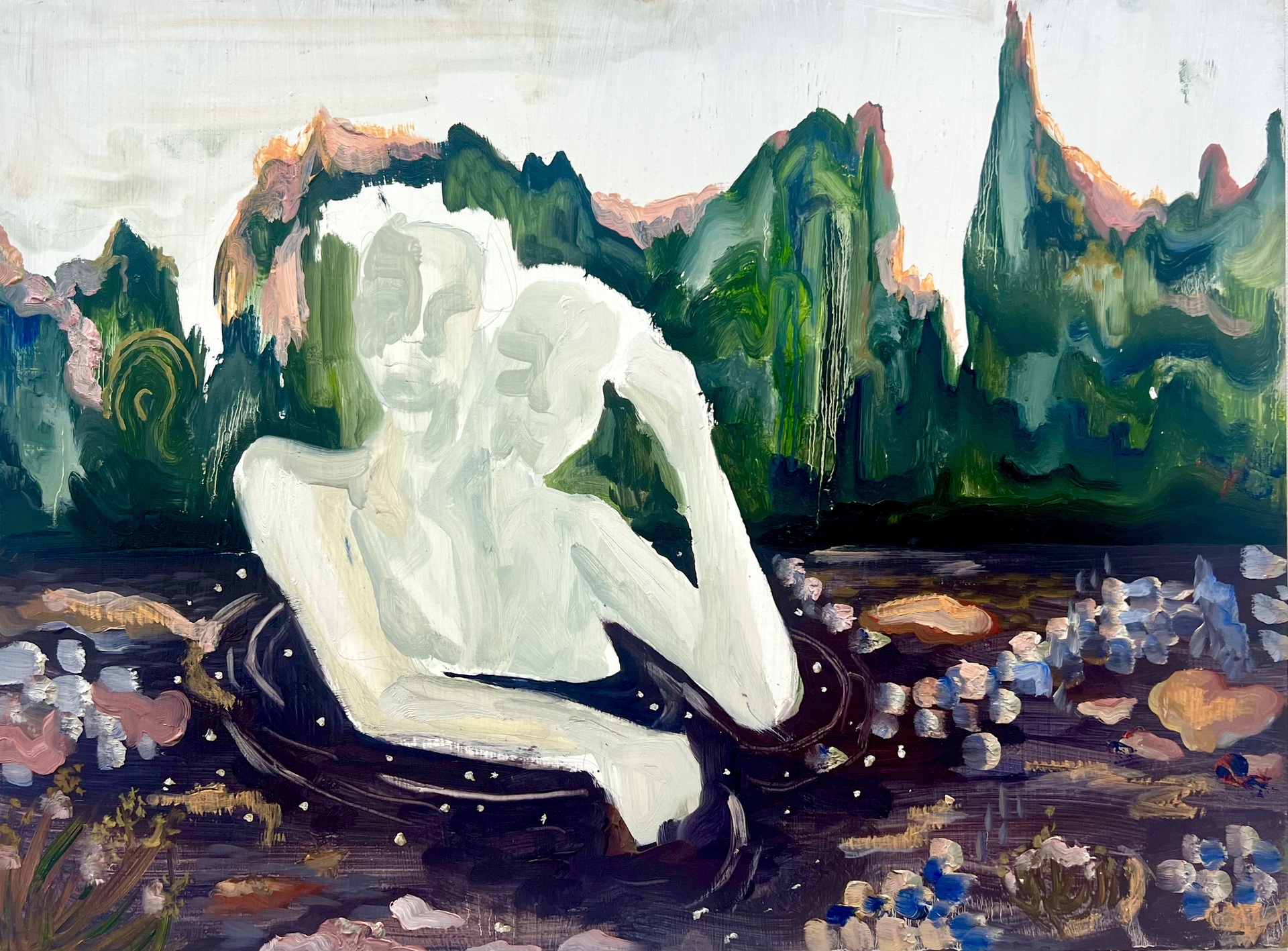 emily koch • Untitled • Oil on masonite (repurposed) • 18” x 24” • Newton, MA • $720 • Koch's images give the aura of a darker toned mythology based wonderland. Holding similarities in color and imagery, the archways in both "Mone Rath" & " The Slithy Toves" seem like open passageways to "Untitled." This trio gives a familiar yet somber feeling, much like the double nature of the two-Headed God Janus of Greek mythos. He looks over passages like the ones that accompany the two-headed woman of "Untitled."
emily koch • Untitled • Oil on masonite (repurposed) • 18” x 24” • Newton, MA • $720 • Koch's images give the aura of a darker toned mythology based wonderland. Holding similarities in color and imagery, the archways in both "Mone Rath" & " The Slithy Toves" seem like open passageways to "Untitled." This trio gives a familiar yet somber feeling, much like the double nature of the two-Headed God Janus of Greek mythos. He looks over passages like the ones that accompany the two-headed woman of "Untitled."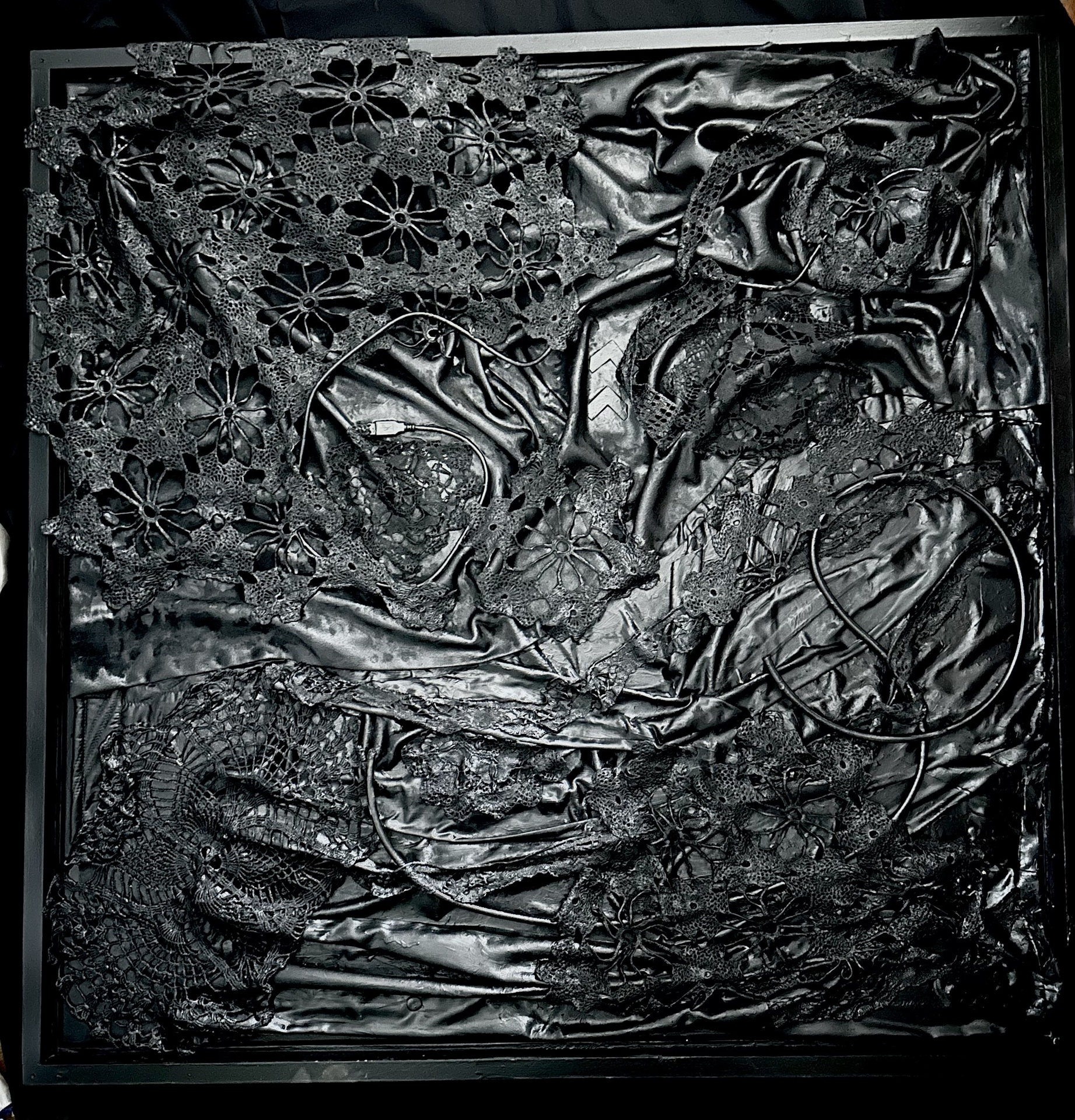 Catherine Lavoie • Journey • Textile - Mixed • 36” x 36” • Bethlehem, CT • $5,000 • Lace, a beautiful, intricate material - made by humans - here saturated in black reminiscent of an oil spill; ruining the earth just like the fabric. This work is circling the acknowledged feeling that people will never be able to purge the Earth of the effects of using and transporting this substance, no matter how creatively humans attempt to dispose of it. The emotive darkness touching the light entices the viewer. The collectivity of the interwoven - yet neglected cotton, pipes and plastic - make viewers seek the mystifying answers hidden beneath.
Catherine Lavoie • Journey • Textile - Mixed • 36” x 36” • Bethlehem, CT • $5,000 • Lace, a beautiful, intricate material - made by humans - here saturated in black reminiscent of an oil spill; ruining the earth just like the fabric. This work is circling the acknowledged feeling that people will never be able to purge the Earth of the effects of using and transporting this substance, no matter how creatively humans attempt to dispose of it. The emotive darkness touching the light entices the viewer. The collectivity of the interwoven - yet neglected cotton, pipes and plastic - make viewers seek the mystifying answers hidden beneath.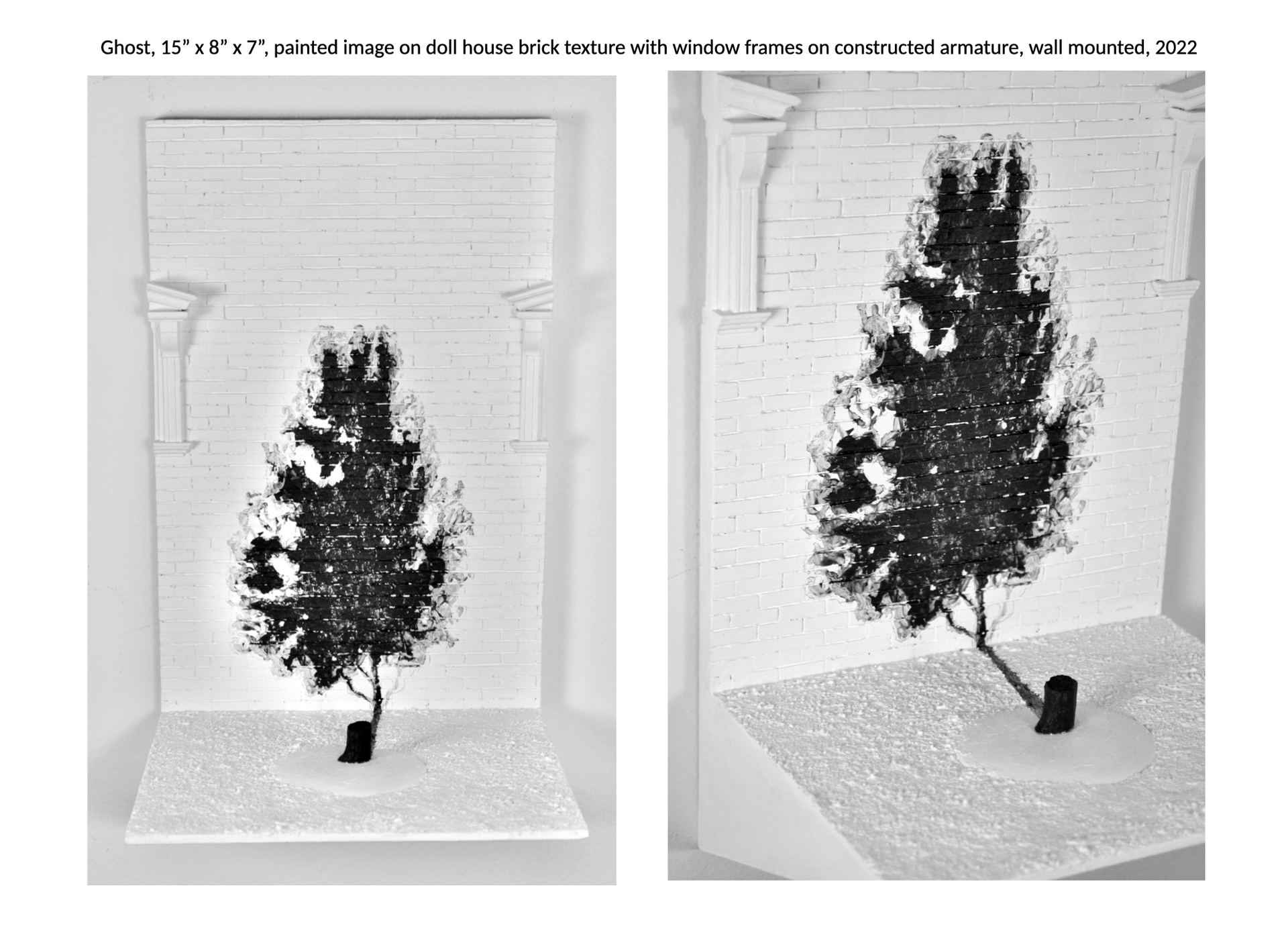 George Lorio • Ghost • Painted fabricated wooden wall relief • 15” x 8” x 7” • Rockville, MD • $3,200 • “Ghost” depicts a stump that was once a thriving tree - giving off oxygen and absorbing the CO2 humans exhale. Now it's just a shadow or husk, with only a burned shadow on the man-made wall behind it to acknowledge its existence.
George Lorio • Ghost • Painted fabricated wooden wall relief • 15” x 8” x 7” • Rockville, MD • $3,200 • “Ghost” depicts a stump that was once a thriving tree - giving off oxygen and absorbing the CO2 humans exhale. Now it's just a shadow or husk, with only a burned shadow on the man-made wall behind it to acknowledge its existence.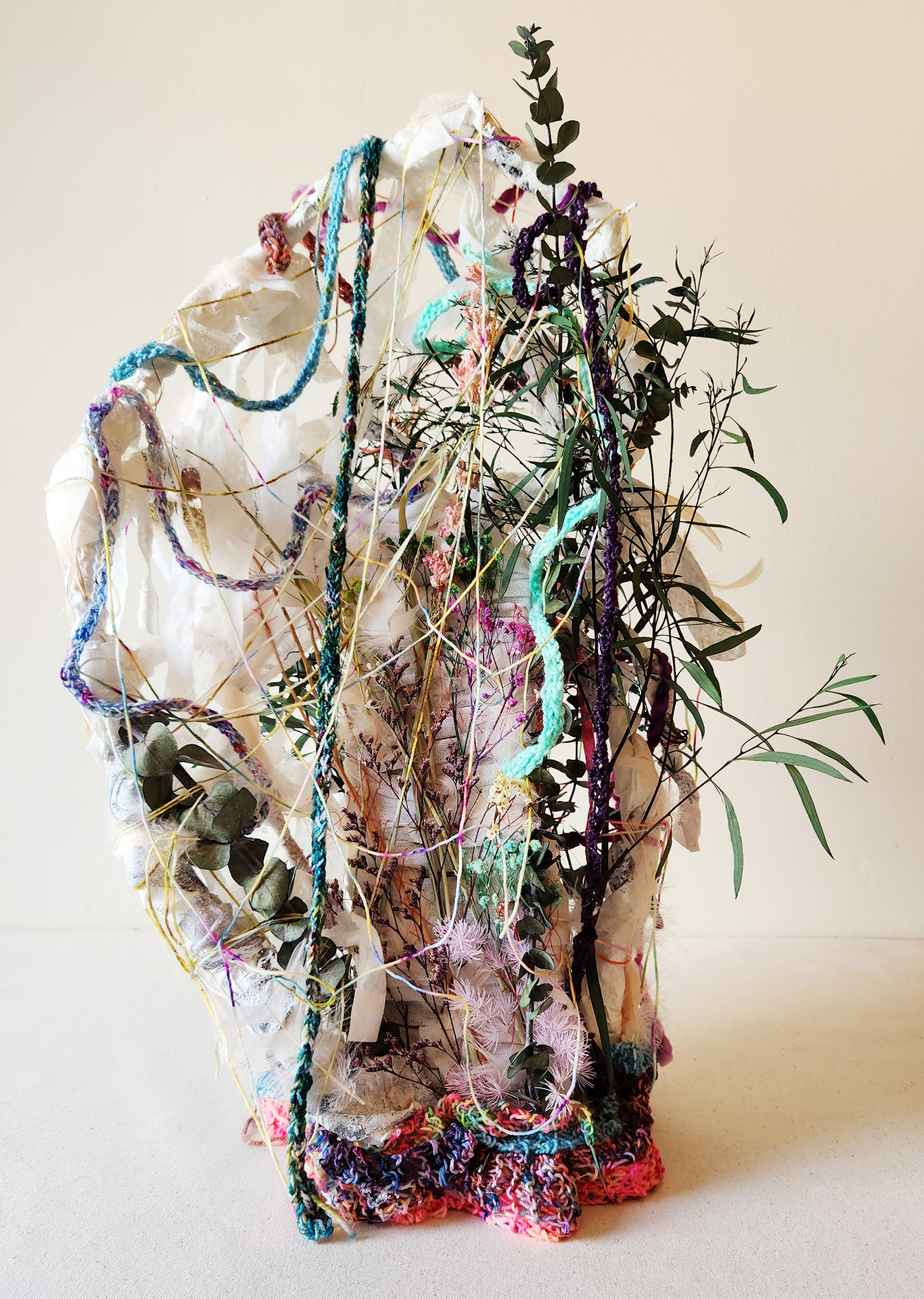 Kristen Martin-Aarnio • Feathery Undergrowth • mixed-media sculpture • 23” x 19” x 11” • Bayonne, NJ • $650 • Recycled trash and found objects are made into extravagant mixed-media sculptures. Martin-Aarino uses materials such as dried flowers, wire, fabric, and cardboard, granting these items a new purpose instead of leaving them to pollute and rot away the environment. These sculptures transform the material into delightfully chaotic pieces that twist and turn thin material that blossoms into something beautiful. These pieces challenge the perception of what is valuable and what is not.
Kristen Martin-Aarnio • Feathery Undergrowth • mixed-media sculpture • 23” x 19” x 11” • Bayonne, NJ • $650 • Recycled trash and found objects are made into extravagant mixed-media sculptures. Martin-Aarino uses materials such as dried flowers, wire, fabric, and cardboard, granting these items a new purpose instead of leaving them to pollute and rot away the environment. These sculptures transform the material into delightfully chaotic pieces that twist and turn thin material that blossoms into something beautiful. These pieces challenge the perception of what is valuable and what is not.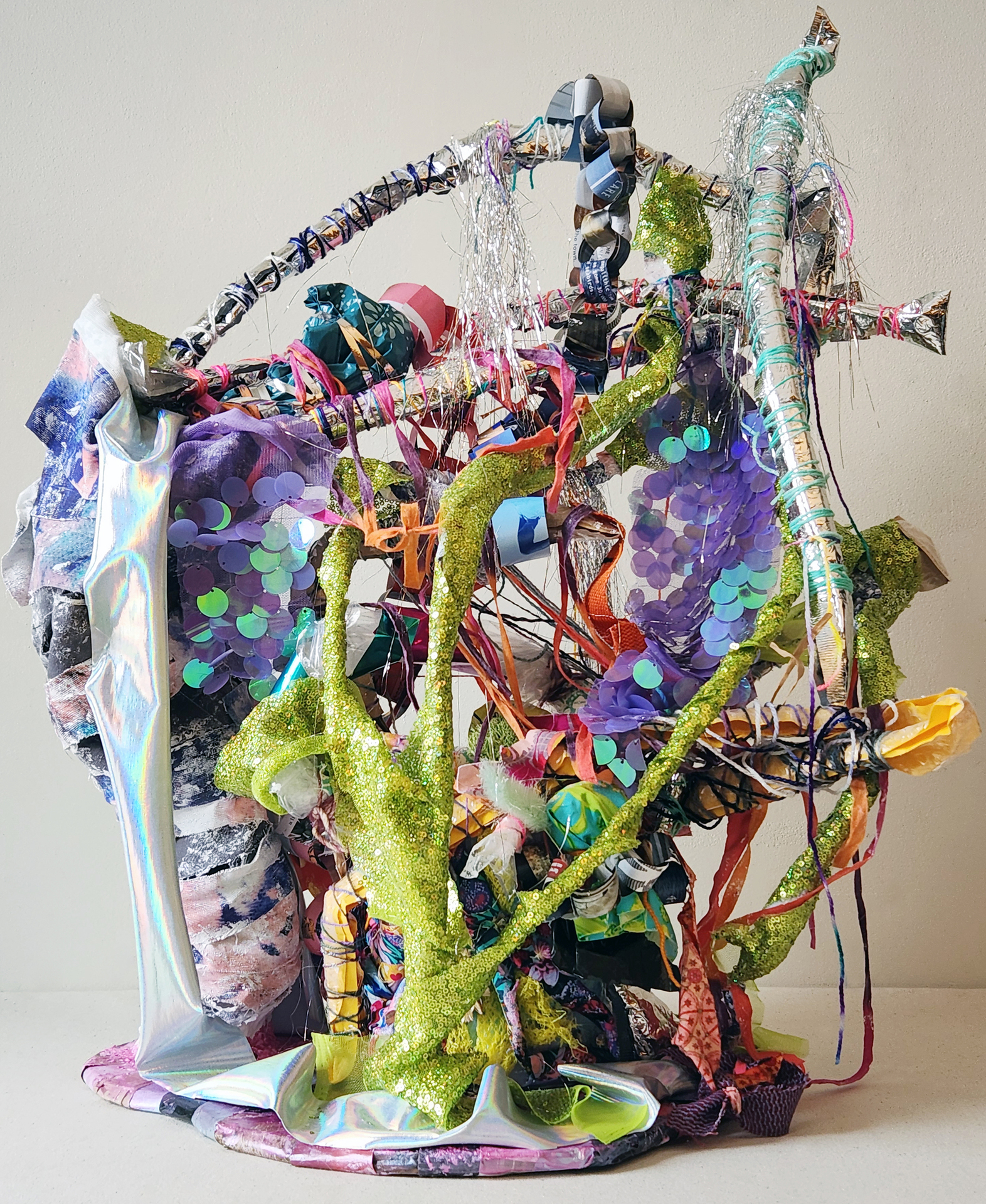 Kristen Martin-Aarnio • Party Pulp • mixed-media sculpture • 28” x 23” x 13” • Bayonne, NJ • $600 • Recycled trash and found objects are made into extravagant mixed-media sculptures. Martin-Aarino uses materials such as dried flowers, wire, fabric, and cardboard, granting these items a new purpose instead of leaving them to pollute and rot away the environment. These sculptures transform the material into delightfully chaotic pieces that twist and turn thin material that blossoms into something beautiful. These pieces challenge the perception of what is valuable and what is not.
Kristen Martin-Aarnio • Party Pulp • mixed-media sculpture • 28” x 23” x 13” • Bayonne, NJ • $600 • Recycled trash and found objects are made into extravagant mixed-media sculptures. Martin-Aarino uses materials such as dried flowers, wire, fabric, and cardboard, granting these items a new purpose instead of leaving them to pollute and rot away the environment. These sculptures transform the material into delightfully chaotic pieces that twist and turn thin material that blossoms into something beautiful. These pieces challenge the perception of what is valuable and what is not.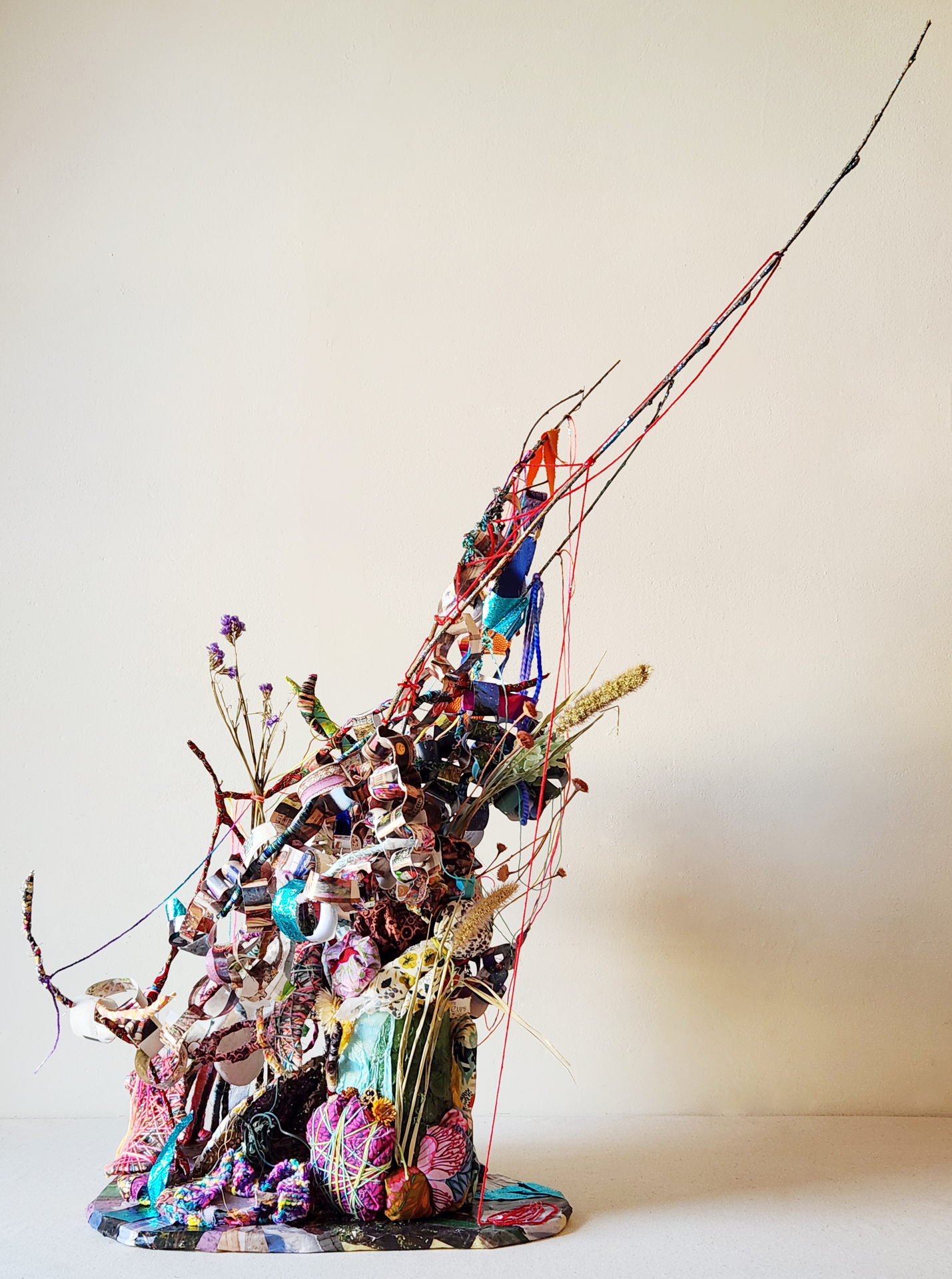 Kristen Martin-Aarnio • Carnival Crash Aftermath • mixed-media sculpture • 35” x 19” x 33” • Bayonne, NJ • $750 • Recycled trash and found objects are made into extravagant mixed-media sculptures. Martin-Aarino uses materials such as dried flowers, wire, fabric, and cardboard, granting these items a new purpose instead of leaving them to pollute and rot away the environment. These sculptures transform the material into delightfully chaotic pieces that twist and turn thin material that blossoms into something beautiful. These pieces challenge the perception of what is valuable and what is not.
Kristen Martin-Aarnio • Carnival Crash Aftermath • mixed-media sculpture • 35” x 19” x 33” • Bayonne, NJ • $750 • Recycled trash and found objects are made into extravagant mixed-media sculptures. Martin-Aarino uses materials such as dried flowers, wire, fabric, and cardboard, granting these items a new purpose instead of leaving them to pollute and rot away the environment. These sculptures transform the material into delightfully chaotic pieces that twist and turn thin material that blossoms into something beautiful. These pieces challenge the perception of what is valuable and what is not.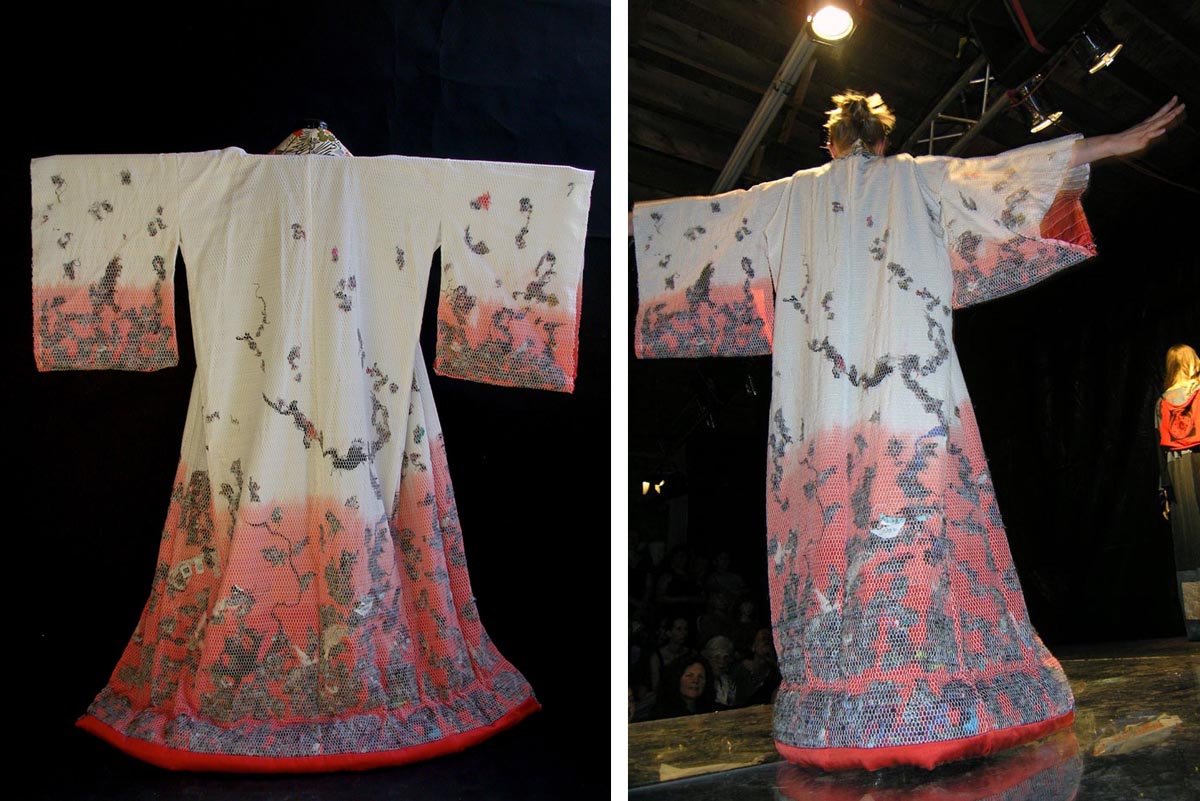 Jen Mecca • Uchikake I • Silk, recycled clothing fiber, netting • 60” x 60” x 4” • Boston, MA • $5,000 • Mecca uses fashion as a presentation of human trends and their destructive impact on nature. The artist uses recycled material to create a deeper meaning in a mainstream way - taking human habits and throwing it back at humanity - using fashion to tell society to do better with its harmful norms and turning waste into something delicate and usable.
Jen Mecca • Uchikake I • Silk, recycled clothing fiber, netting • 60” x 60” x 4” • Boston, MA • $5,000 • Mecca uses fashion as a presentation of human trends and their destructive impact on nature. The artist uses recycled material to create a deeper meaning in a mainstream way - taking human habits and throwing it back at humanity - using fashion to tell society to do better with its harmful norms and turning waste into something delicate and usable.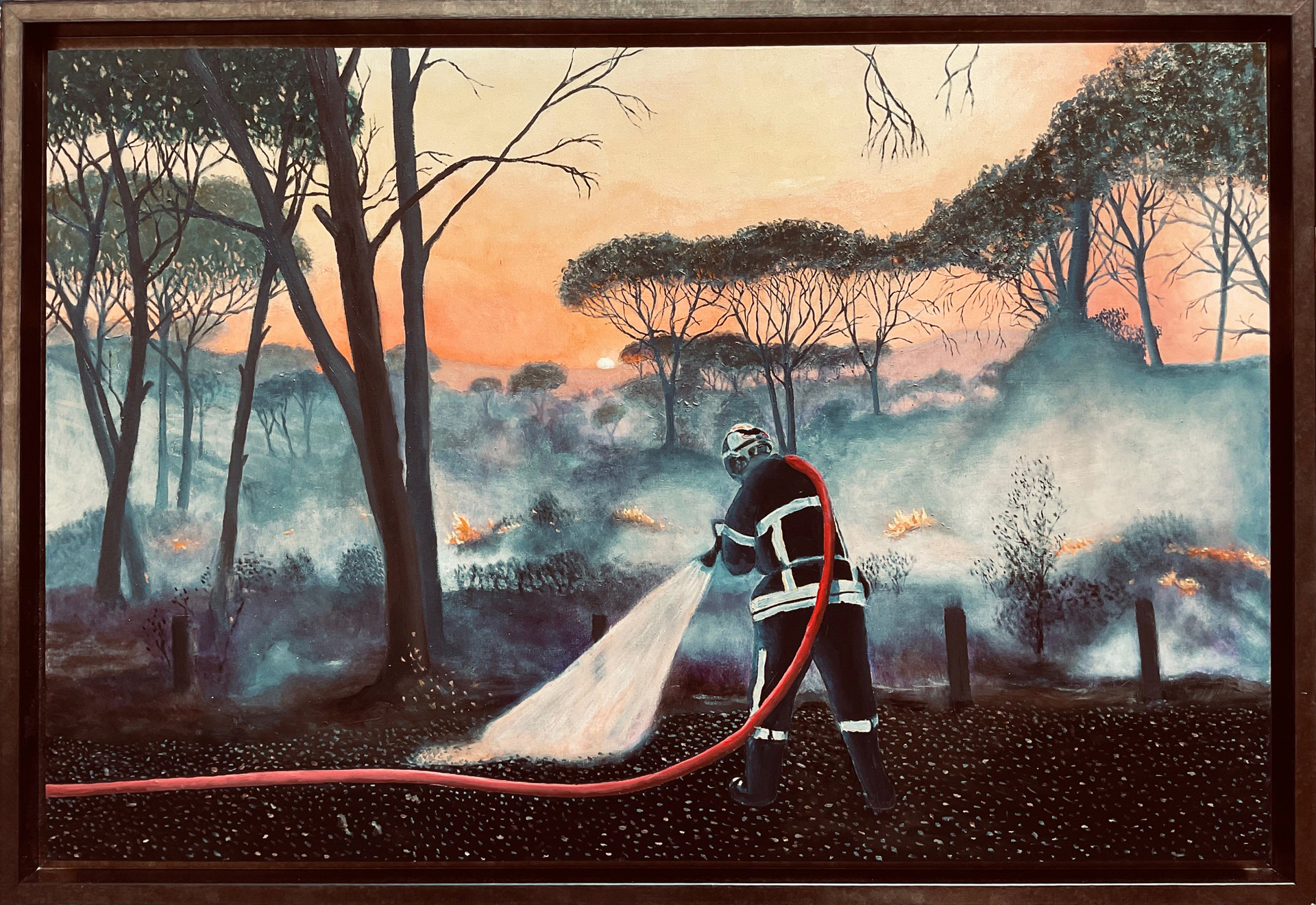 Edward Mills • Vineyard Fire • Oil on Board • 26.5” x 38.5” • Brooklyn, NY • $10,000 • Beautiful but destructive in nature, at nature, to nature. Completely devastating. These fires are a product of humans continually making things worse, no matter if they try to rectify their mistakes. Patches of land previously luscious and thriving are now sparse and barren.The forest fires are devouring trees faster than humans can possibly save them. Fire, all consuming and unforgiving, continues on as a lone firefighter persists to make a difference.
Edward Mills • Vineyard Fire • Oil on Board • 26.5” x 38.5” • Brooklyn, NY • $10,000 • Beautiful but destructive in nature, at nature, to nature. Completely devastating. These fires are a product of humans continually making things worse, no matter if they try to rectify their mistakes. Patches of land previously luscious and thriving are now sparse and barren.The forest fires are devouring trees faster than humans can possibly save them. Fire, all consuming and unforgiving, continues on as a lone firefighter persists to make a difference.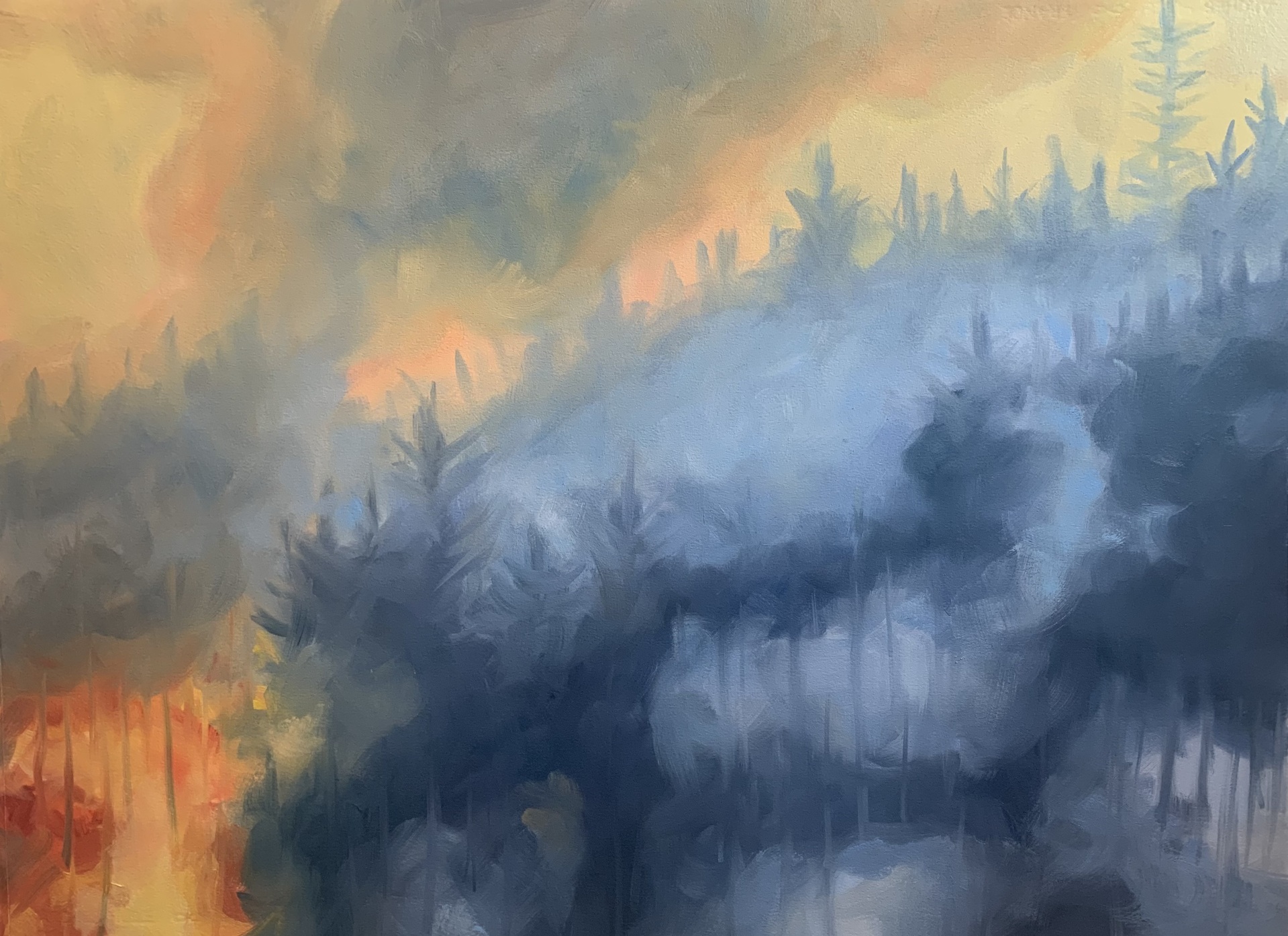 Kellyann Monaghan • Signs of Resilience III • oil on paper • 22” x 30” • Brooklyn, NY • $2,000 • Altering climate conditions have inspired Monaghan’s path of painting. Weather carries a sense of reflection, urging us to notice its significant impact on the planet. The energetic orange merging with a moodier blue are the destructive but abrupt beauties of nature that Monaghan adores. By using dynamic expression, texture, and gestural brushwork, the creation of her landscapes captures the effecting weather events caused by climate change.
Kellyann Monaghan • Signs of Resilience III • oil on paper • 22” x 30” • Brooklyn, NY • $2,000 • Altering climate conditions have inspired Monaghan’s path of painting. Weather carries a sense of reflection, urging us to notice its significant impact on the planet. The energetic orange merging with a moodier blue are the destructive but abrupt beauties of nature that Monaghan adores. By using dynamic expression, texture, and gestural brushwork, the creation of her landscapes captures the effecting weather events caused by climate change. Lala Montoya • Heal The Land So She Can Grow Our Medicine • Woodblock Print • 55” x 12” • Poughkeepsie, NY • $350 • Abundant with historical meaning and connections to nature, this piece represents the connection between humans and plants and how beauty can come from us. It shows a hand with roots intertwined around it that continue to grow into far-reaching flowers. It reminds us that with effort we can make great change.
Lala Montoya • Heal The Land So She Can Grow Our Medicine • Woodblock Print • 55” x 12” • Poughkeepsie, NY • $350 • Abundant with historical meaning and connections to nature, this piece represents the connection between humans and plants and how beauty can come from us. It shows a hand with roots intertwined around it that continue to grow into far-reaching flowers. It reminds us that with effort we can make great change.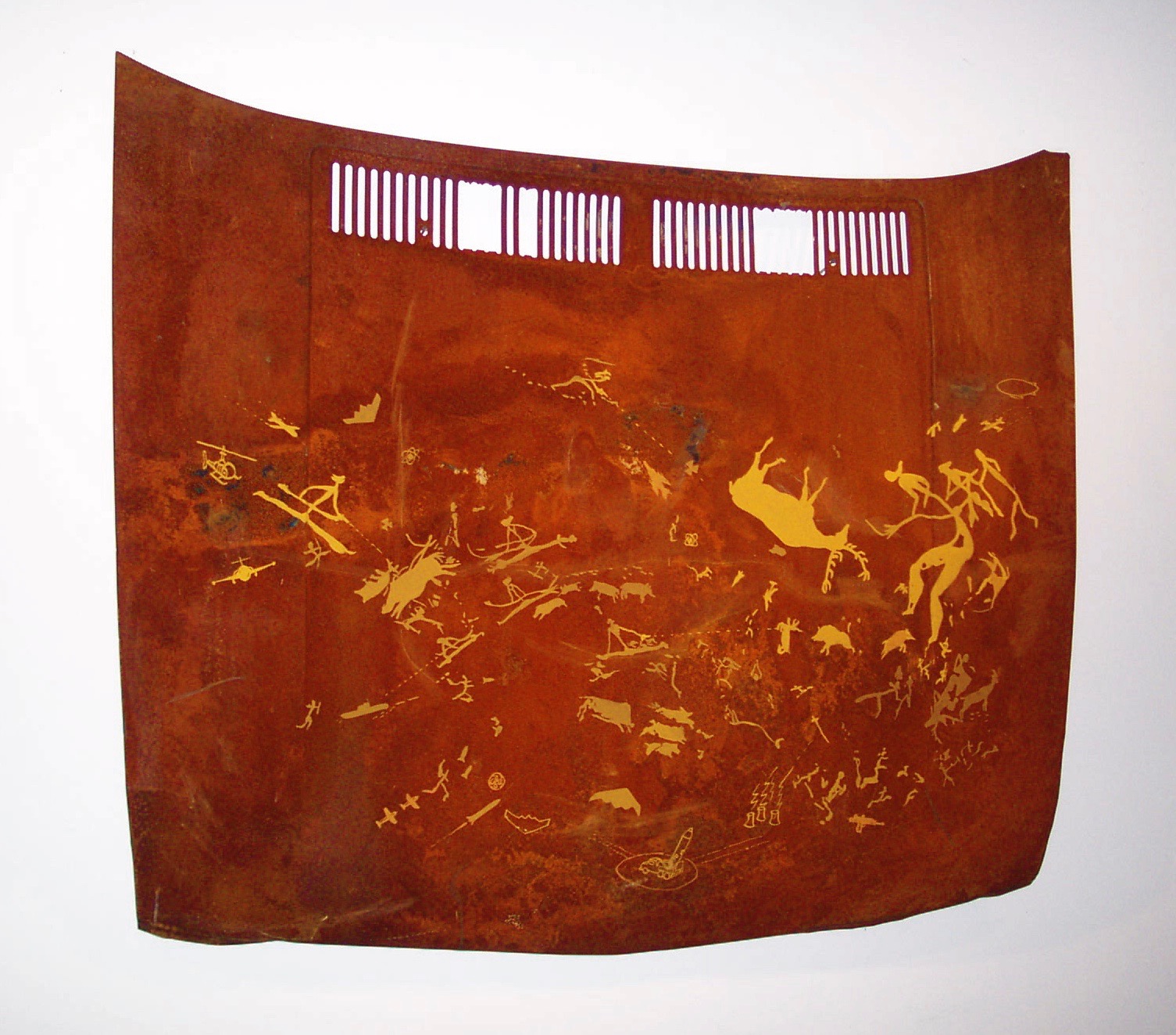 Franc Palaia • "When Will We Learn" • tempera on metal car hood • 45” x 54” x 5” • Rhinebeck, NY • $5,000 • Inspired by old cave art of the Paleolithic period, Palaia painted "When Will We Learn". Similar to the predominant theme of animals in paleolithic cave art, weapons have become more adaptable to human beings, making gaining power over their environments easier. Reclaiming an old rusty car hood, Palaia paints the violence and oppressive control people of this world have upon our countries as it is embedded into history.
Franc Palaia • "When Will We Learn" • tempera on metal car hood • 45” x 54” x 5” • Rhinebeck, NY • $5,000 • Inspired by old cave art of the Paleolithic period, Palaia painted "When Will We Learn". Similar to the predominant theme of animals in paleolithic cave art, weapons have become more adaptable to human beings, making gaining power over their environments easier. Reclaiming an old rusty car hood, Palaia paints the violence and oppressive control people of this world have upon our countries as it is embedded into history.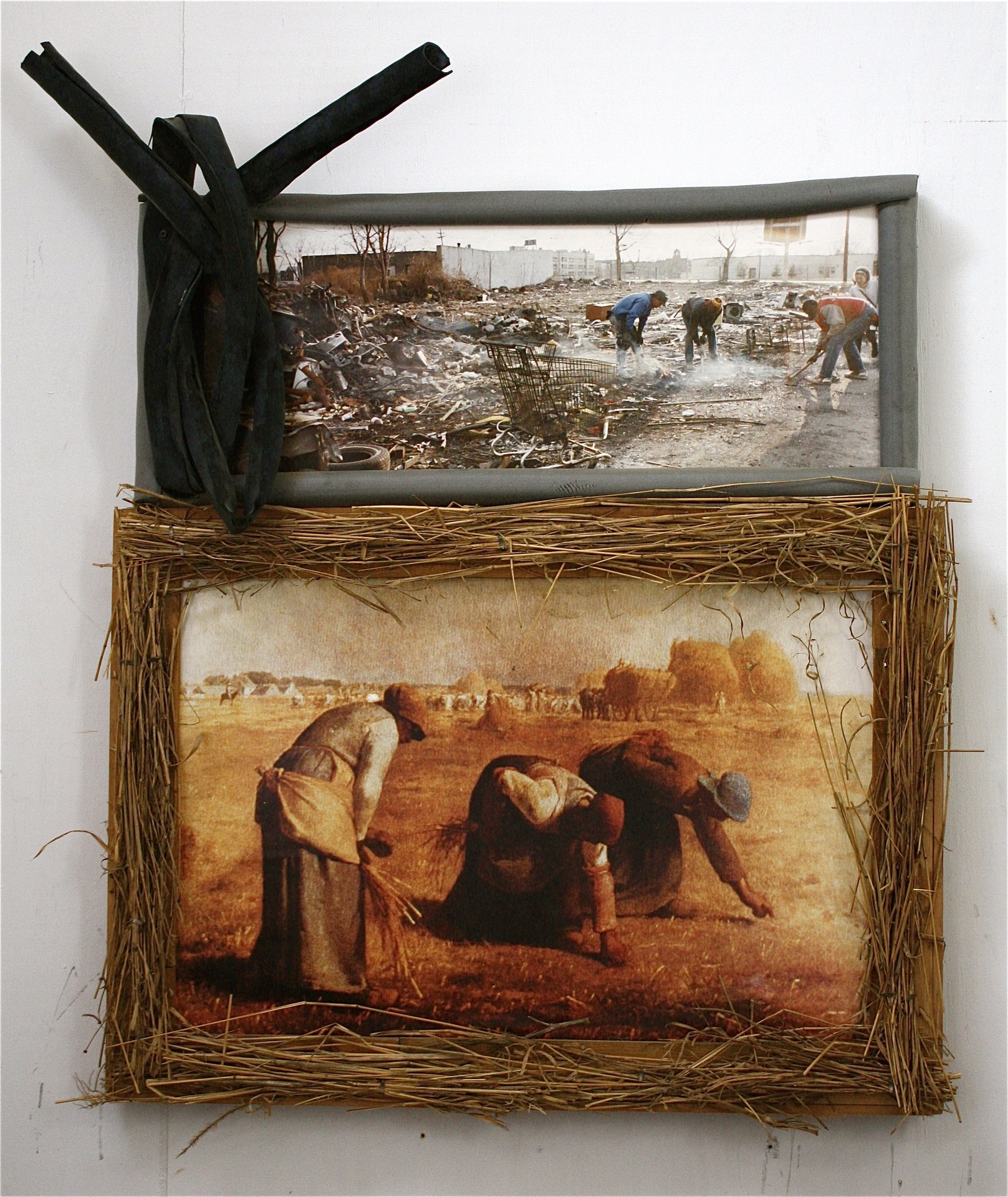 Franc Palaia • Gleaners • color photographs, wood, foam rubber, straw • 48” x 40” x 5” • Rhinebeck, NY • $4,000 • In this piece, Palaia, compares two images. The bottom images are of gleaners collecting leftover grain; a surplus which will nourish themselves and their families. The hay bales in the background symbolize abundance and hardwork. But the work above is of workers or volunteers - picking up trash and discarded materials in an abandoned lot. In the past we did hard labor picking up natural resources to feed and celebrate our lives but now we're picking up trash and non-natural pollutants as we desperately try to save ourselves from the disaster we created.
Franc Palaia • Gleaners • color photographs, wood, foam rubber, straw • 48” x 40” x 5” • Rhinebeck, NY • $4,000 • In this piece, Palaia, compares two images. The bottom images are of gleaners collecting leftover grain; a surplus which will nourish themselves and their families. The hay bales in the background symbolize abundance and hardwork. But the work above is of workers or volunteers - picking up trash and discarded materials in an abandoned lot. In the past we did hard labor picking up natural resources to feed and celebrate our lives but now we're picking up trash and non-natural pollutants as we desperately try to save ourselves from the disaster we created.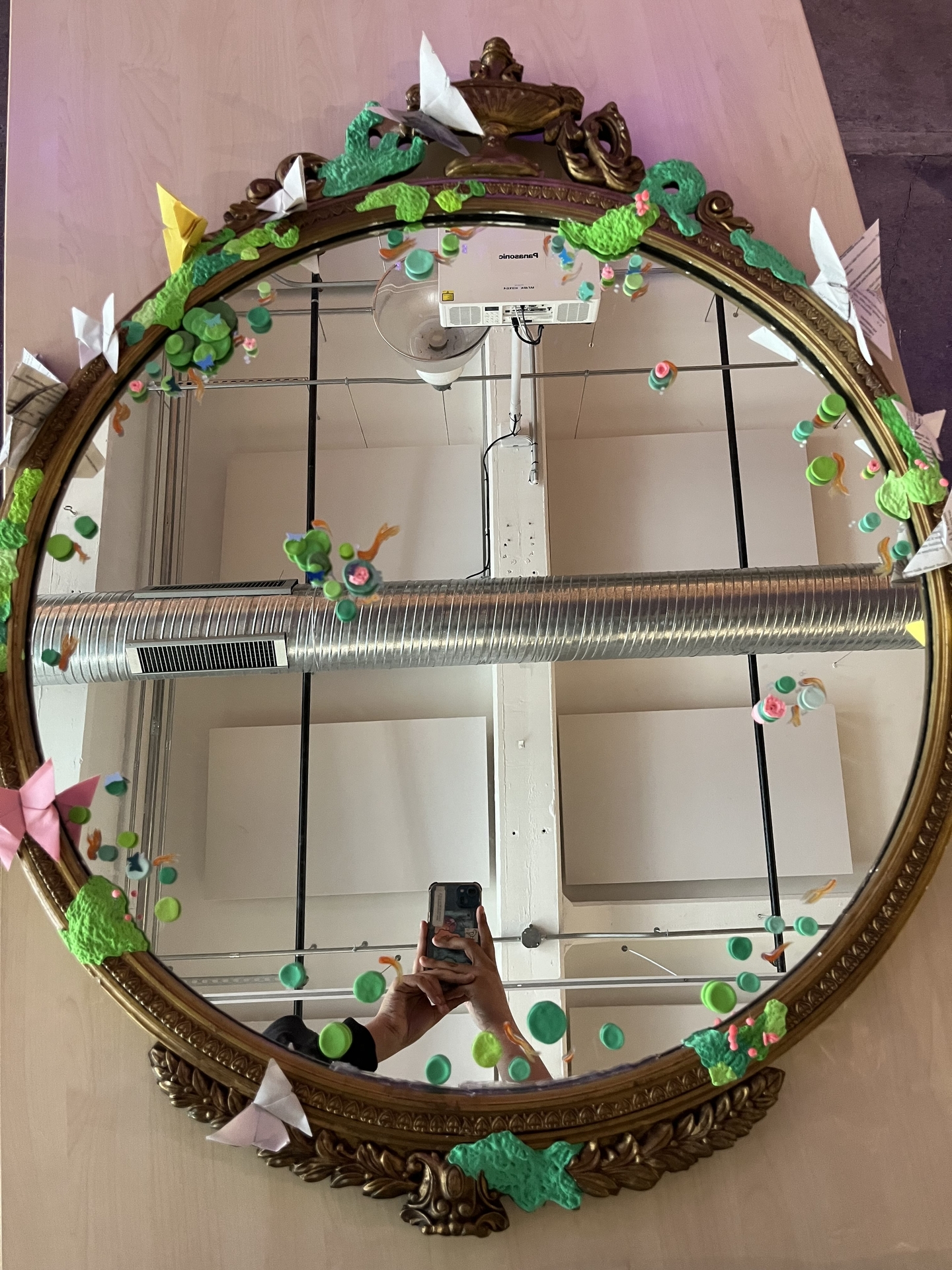 PalmSun • Lake reflecting back • paper, clay and forgotten mirror • 38” x 32” • Poughkeepsie, NY • $300 • PalmSun uses found objects and clay to create both a calm and almost peaceful landscape and fractured chaotic warning pieces, exploring different elements of natural reflection.Trying to convey what reuse can look like from an artistic standpoint, PalmSun aims to merge the gap between art, artist, and viewer. Viewers are encouraged to take a photo within the rounded mirror piece and reflect on where the mirrors have been and how they change with time.
PalmSun • Lake reflecting back • paper, clay and forgotten mirror • 38” x 32” • Poughkeepsie, NY • $300 • PalmSun uses found objects and clay to create both a calm and almost peaceful landscape and fractured chaotic warning pieces, exploring different elements of natural reflection.Trying to convey what reuse can look like from an artistic standpoint, PalmSun aims to merge the gap between art, artist, and viewer. Viewers are encouraged to take a photo within the rounded mirror piece and reflect on where the mirrors have been and how they change with time. PalmSun • the mirrors often forgotten • clay and forgotten mirrors • 17.5” x 20.5” • Poughkeepsie, NY • $70 • PalmSun uses found objects and clay to create both a calm and almost peaceful landscape and fractured chaotic warning pieces, exploring different elements of natural reflection.Trying to convey what reuse can look like from an artistic standpoint, PalmSun aims to merge the gap between art, artist, and viewer. Viewers are encouraged to take a photo within the rounded mirror piece and reflect on where the mirrors have been and how they change with time.
PalmSun • the mirrors often forgotten • clay and forgotten mirrors • 17.5” x 20.5” • Poughkeepsie, NY • $70 • PalmSun uses found objects and clay to create both a calm and almost peaceful landscape and fractured chaotic warning pieces, exploring different elements of natural reflection.Trying to convey what reuse can look like from an artistic standpoint, PalmSun aims to merge the gap between art, artist, and viewer. Viewers are encouraged to take a photo within the rounded mirror piece and reflect on where the mirrors have been and how they change with time.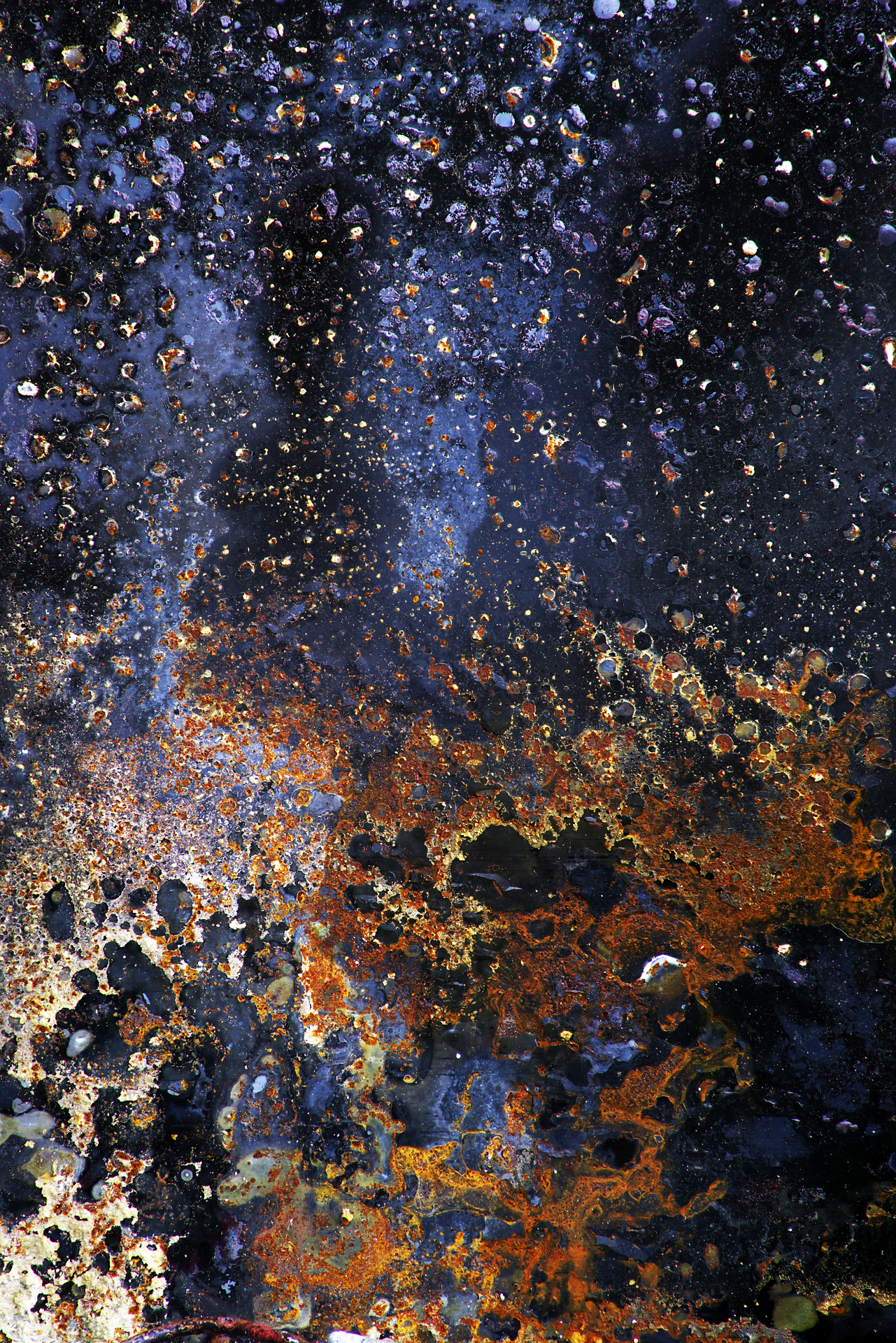 Jack Straton • Crescent arising from the Holiday Farm Fire, Blue River, OR • Archival Lucia Pro pigment ink print • 19” x 13” • Portland, OR • $290 • A fire spread throughout a community destroying homes and structures over 173,393 acres of land. Smog and smoke plagued a community and two counties. But Straton’s photo captures something found in the aftermath. It conveys fire in a way that isn’t usually seen in the media and the damaged indents in the metal remains look like stars illuminating a dark night sky.
Jack Straton • Crescent arising from the Holiday Farm Fire, Blue River, OR • Archival Lucia Pro pigment ink print • 19” x 13” • Portland, OR • $290 • A fire spread throughout a community destroying homes and structures over 173,393 acres of land. Smog and smoke plagued a community and two counties. But Straton’s photo captures something found in the aftermath. It conveys fire in a way that isn’t usually seen in the media and the damaged indents in the metal remains look like stars illuminating a dark night sky.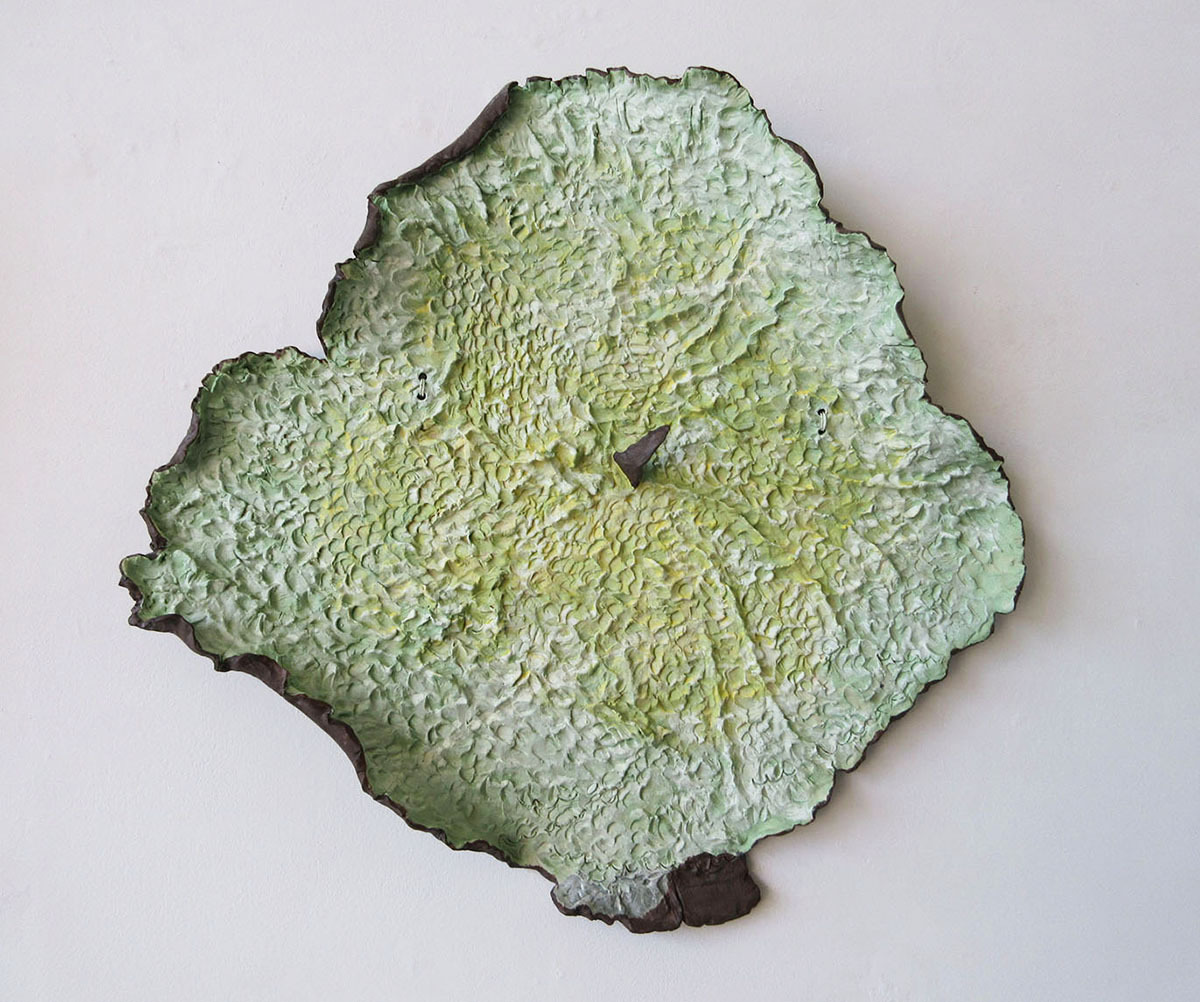 Naomi Teppich • Liking the Lichen • Glazed stoneware wall sculpture • 20” x 21” x 3.5” • Damascus, PA • $1,200 • A nature-inspired clay piece made through environmentally friendly methods. It recreates a plant called the Lichen that has great natural power. A lichen is actually a symbiotic partnership of a fungus and an algae, which has the ability to dissolve rock and turn it to soil. The green covering of the piece shows how the organism covers a surface to break it down. This represents the power that natural things can have on their own.
Naomi Teppich • Liking the Lichen • Glazed stoneware wall sculpture • 20” x 21” x 3.5” • Damascus, PA • $1,200 • A nature-inspired clay piece made through environmentally friendly methods. It recreates a plant called the Lichen that has great natural power. A lichen is actually a symbiotic partnership of a fungus and an algae, which has the ability to dissolve rock and turn it to soil. The green covering of the piece shows how the organism covers a surface to break it down. This represents the power that natural things can have on their own.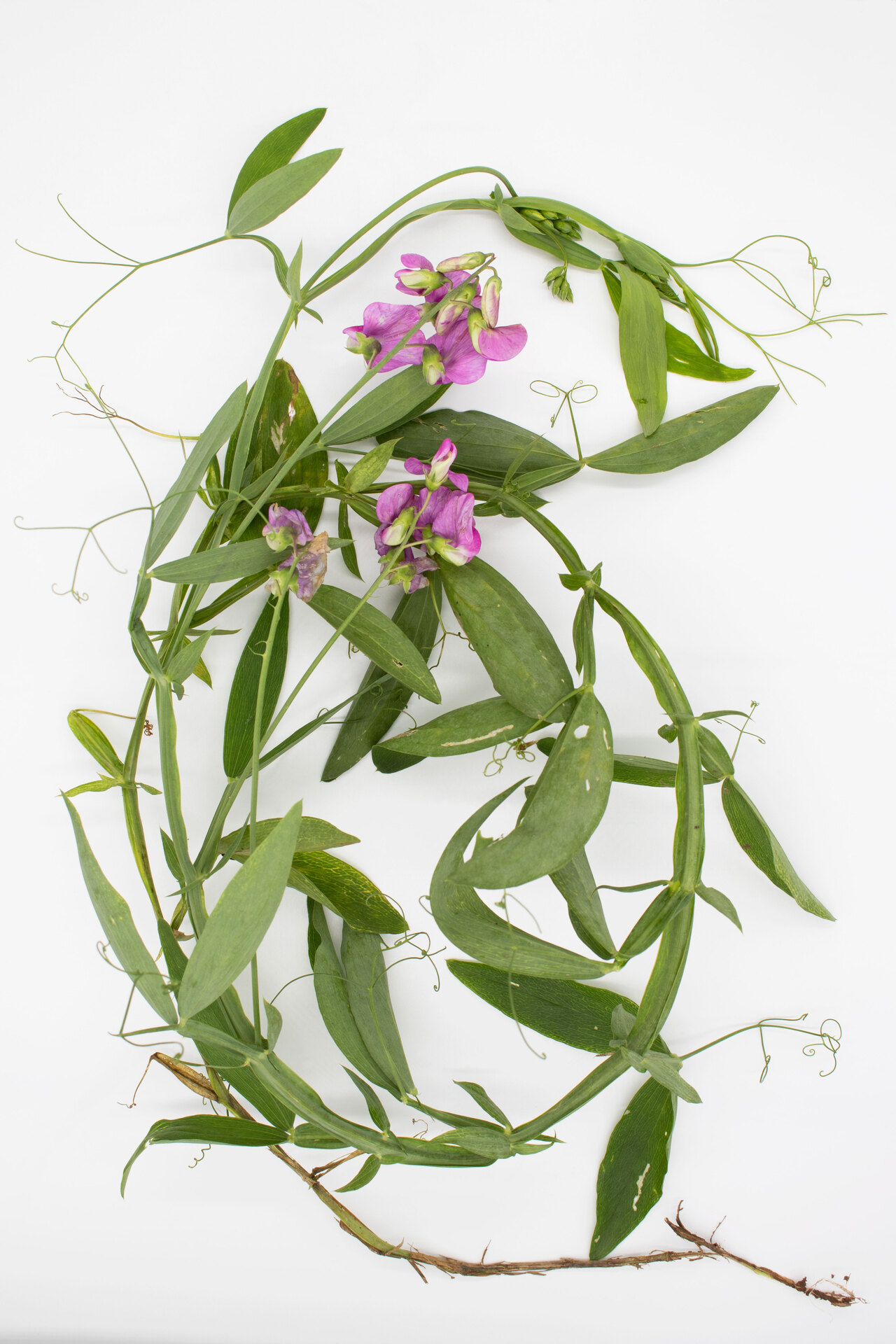 Nathaniel Udell • Comes with the Territory, Invasive #12 - Perennial Pea • Color Photograph • 36” x 24” • Jeffersonville, NY • $1,200 • An invasive beauty that was taken from nature and has become unsoiled and idealistically displayed. This plant can be easily found in a backyard but little people know of its intrusive history. It is a long vine-like plant that grows an attractive flower that catches the eye. It is important to remember that beauty can hide the nature and past of things.
Nathaniel Udell • Comes with the Territory, Invasive #12 - Perennial Pea • Color Photograph • 36” x 24” • Jeffersonville, NY • $1,200 • An invasive beauty that was taken from nature and has become unsoiled and idealistically displayed. This plant can be easily found in a backyard but little people know of its intrusive history. It is a long vine-like plant that grows an attractive flower that catches the eye. It is important to remember that beauty can hide the nature and past of things.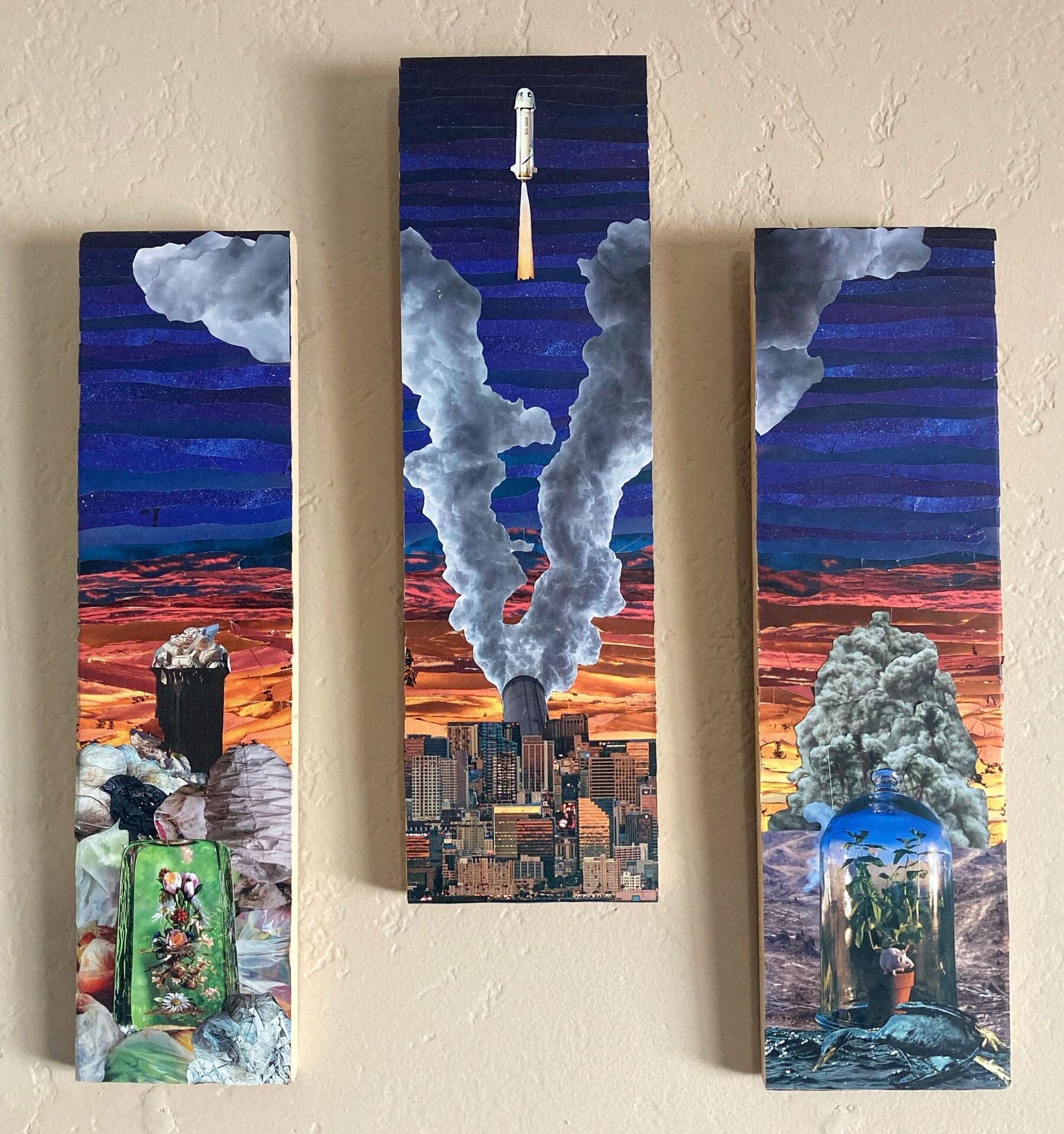 G.E. Vogt • Going going gone… • Collage: Magazine and found images on kitchen cutting board • 21” x 18” • San Diego, CA • $750 • Vogt creates the triptych Going Going Gone…, which depicts the fleeting moments of the world ending as a spaceship is sent off to space. The collage brings elements of old and new magazines that tell a story of external factors, such as socioeconomic class in society, which deeply connect to an individual’s outlook on the world. The rich can buy a whole spaceship and fly off, avoiding the nightmare, preserving what little of Earth is left, reinforcing the physical and psychological gap between our Earth and its people.
G.E. Vogt • Going going gone… • Collage: Magazine and found images on kitchen cutting board • 21” x 18” • San Diego, CA • $750 • Vogt creates the triptych Going Going Gone…, which depicts the fleeting moments of the world ending as a spaceship is sent off to space. The collage brings elements of old and new magazines that tell a story of external factors, such as socioeconomic class in society, which deeply connect to an individual’s outlook on the world. The rich can buy a whole spaceship and fly off, avoiding the nightmare, preserving what little of Earth is left, reinforcing the physical and psychological gap between our Earth and its people.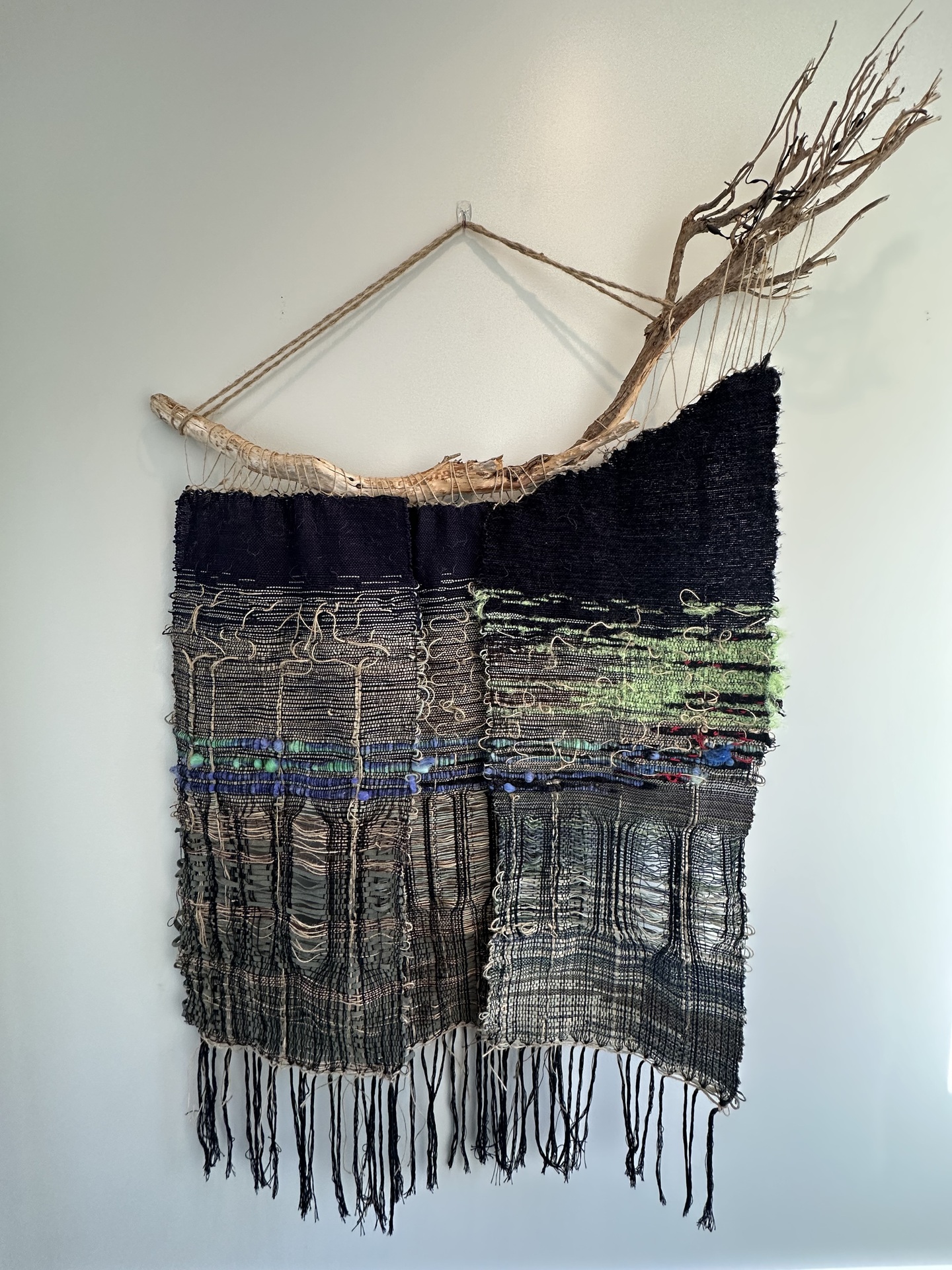 Elena Zotova • Kairos • Textile • 60” x 44” x 2” • Saco, ME • $750 • Zotova created this piece, "Kairos" using the meditative SAORI hand-weaving technique and attaching the textile to a piece of driftwood. The free-flowing hand weave process is one of connection - connection to the craft, to the creative, to others, and in Zotova's case, to our planet, our home. "Kairos," Greek for 'right time,' confronts people's responsibility in taking climate action. Inspired by Zotova's reaction to the words "Time & Temperature," the piece speaks to the urgency of increased temperatures and environmental disasters, inspiring a call to action. Will you pick up the loose threads?
Elena Zotova • Kairos • Textile • 60” x 44” x 2” • Saco, ME • $750 • Zotova created this piece, "Kairos" using the meditative SAORI hand-weaving technique and attaching the textile to a piece of driftwood. The free-flowing hand weave process is one of connection - connection to the craft, to the creative, to others, and in Zotova's case, to our planet, our home. "Kairos," Greek for 'right time,' confronts people's responsibility in taking climate action. Inspired by Zotova's reaction to the words "Time & Temperature," the piece speaks to the urgency of increased temperatures and environmental disasters, inspiring a call to action. Will you pick up the loose threads?
